
In 2024, Revealing Translation Methods Netflix Subtitle Software Comprehensive Guide

Revealing Translation Methods: Netflix Subtitle Software Comprehensive Guide
Subtitle translation on Netflix plays a pivotal role in enhancing the global viewership experience. With Netflix’s expansive reach across diverse linguistic demographics, accurate Netflix translation ensures accessibility and inclusivity for audiences worldwide. Subtitles not only cater to non-native speakers but also serve the needs of the deaf and hard-of-hearing community fostering a more comprehensive viewing environment.
The importance of precise translation lies in preserving the nuances of dialogue, cultural references, and context, thus maintaining the authenticity of the content. To address this, various software tools and methods, including Netflix subtitles translator, are employed, leveraging technology and human expertise to ensure high-quality translations. In this article, we will explore various software and methods for translating subtitles on Netflix effectively.
Part 1: Difficulties Lies in Netflix Subtitle Translation

Translating subtitles for Netflix is a multifaceted endeavor that extends beyond linguistic conversion. It entails delicately navigating cultural nuances, balancing precision with sensitivity, and encapsulating dialogue essence within tight constraints.
As Netflix expands globally, high-quality translation Netflix becomes crucial for a seamless viewing experience. To deepen comprehension, here are the complexities inherent in Netflix subtitle translation:
● Preserving Cultural Nuances
This involves accurately conveying cultural references, humor, and idiomatic expressions while ensuring they resonate with the target audience. It requires translators to understand the cultural context deeply to maintain the authenticity of the content.
● Balancing Linguistic Accuracy and Cultural Sensitivity
Achieving a balance between linguistic precision and cultural relevance is crucial to avoid misinterpretations or causing offense. Translators must ensure that their translations accurately reflect the original meaning while remaining sensitive to cultural differences.
● Interpreting Context
Understanding the context of dialogues and scenes is essential for translation accurately. This is particularly challenging when cultural context significantly influences meaning which requires translators to grasp subtle nuances and implications.
● Time Constraints and Character Limits
Subtitles must be concise and displayed within limited screen space. Translators face the challenge of conveying meaning efficiently without sacrificing accuracy under strict time and space constraints.
● Technical Challenges
Translators often work with specific software and must adhere to technical guidelines provided by Netflix. This includes subtitles formatting and timing, which requires proficiency in technical aspects alongside linguistic skills.
● Maintaining Consistency
Consistency in terminology, style, and tone across episodes or seasons is essential for a seamless viewing experience. Translators need to ensure that their translations remain coherent and consistent throughout the content.
● Adapting to Language Evolution
Languages evolve over time, and translators need to stay updated with contemporary usage and emerging expressions. This requires ongoing education awareness of linguistic trends to ensure translations remain relevant and accurate.
Part 2: How to Translate Netflix Subtitle Using a Dedicated Tool - Wondershare Virbo
Netflix subtitle translation can indeed feel daunting at first, with its complexities and nuances. However, fear not, for with Wondershare Virbo as your trusted companion, what may initially seem like a daunting task quickly transforms into a smooth and ultimately rewarding experience.

Get Started Online Free Download
In this guide, we will demonstrate how Virbo’s user-friendly interface and advanced features make translating Netflix subtitles a breeze. Follow the instructions outlined below:
- Step 1: Simply open your browser and enter Wondershare Virbo into the search bar. If you don’t have an account yet, you can create one by following the registration process. If you already have an existing account, log in using your credentials.

Get Started Online Free Download
- Step 2: After logging in to your account, navigate to the top of the page and click on the Feature option. From there, select AI Video Translate.

- Step 3: You’ll find instructions on how to use the Video Translate feature of Wondershare Virbo. Scroll down and locate two buttons: Free Download and Translate Video Online. Click on the Translate Video Online button.

- Step 4: Select the Upload Video icon and choose the video from your local files by clicking Open. Allow some time for the video to upload.

- Step 5: Once the video has been uploaded successfully, choose the original video language from the dropdown menu on the left.

- Step 6: Following that, proceed to select the target language from the dropdown menu on the right.

- Step 7: Click on the dropdown menu for Advanced settings, then toggle on both Subtitle and Proofread video script options. Below, click the Translate the video button.
_Note: _If the video primarily showcases one individual’s frontal face, you can also enable Lip-sync by toggling it on.

- Step 8: Wait until the loading process is complete. Once done, review the subtitles to ensure they meet the standards. If necessary, you can edit them before clicking the Save button.

- Step 9: Once you’ve finished reviewing or editing, click on the Translate video button and wait until the video has been successfully translated.

- Step 10: To access the translated video for download, simply click on the Download video button below.

Part 3: What Are The Methods and Tips for Effective Netflix Subtitle Translation?

Netflix, a renowned entertainment platform, offers a wide range of shows and movies to audiences worldwide. Subtitles play a crucial role in ensuring that viewers from different language backgrounds can enjoy the content. In this section, we will discuss various methods and techniques aimed at enhancing the quality of subtitle translation on Netflix.
● Maintaining Context, Tone, and Style
Translating subtitles requires more than just converting words. Translators must grasp the content of each dialogue and scene to accurately convey the intended meaning. They consider factors like character emotions, background information, and narrative flow to ensure the translated subtitles resonate with viewers. Consistency in tone and style across subtitles maintains the immersive experience for the audience to ensure they remain engaged with the content.
● Handling Cultural References and Idiomatic Expressions
Cultural references and idiomatic expressions are integral parts of language and storytelling. However, they can be challenging to translate accurately, especially when the cultural context differs between languages. Translators need to carefully adapt these elements to ensure they make sense to the target audience while staying true to the original intent of the content.
● Adapting Linguistic Nuances
Languages have their own unique nuances and subtleness that may not have direct equivalents in other languages. Translators must navigate these differences skillfully to preserve the richness and depth of the original dialogue. This involves understanding linguistic nuances such as wordplay, sarcasm, metaphor, and finding appropriate equivalents in the target language.
● Utilizing Translation Tools and Technology
Translation software and tools can significantly streamline the subtitle translation process, improving efficiency and consistency. However, these tools are not reliable and require human oversight. Translators leverage technology to enhance their workflow while also relying on their linguistic expertise and cultural awareness to produce high-quality translations.
● Collaboration and Peer Review
Collaboration with fellow translators and subject matter experts is invaluable in ensuring the quality of consistency of subtitle translations. Peer review allows translators to receive constructive feedback, identify potential errors or inconsistencies, and refine their translations accordingly. This collaborative approach helps maintain the overall quality of subtitle translations and ensures that the final product meets the highest standards.
● Cultural Sensitivity and Awareness
Cultural sensitivity is paramount in subtitle translation, as translations that disregard cultural norms or sensitivities can lead to misunderstandings or offense. Translators must conduct thorough research into the cultural context of the source material and seek feedback from native speakers to ensure that their translations are respectful, accurate, and culturally appropriate.
By embracing these best practices, translators can effectively bridge linguistic and cultural barriers that will ensure Netflix subtitles resonate with diverse audiences worldwide.
Conclusion
In this comprehensive guide to Netflix subtitle translation, we’ve explored the intricate process of making content accessible across languages. We’ve discussed the hurdles faced by translators, from preserving cultural nuances to maintaining linguistic precision. Subtitle translation transcends mere word conversion; it is about facilitating seamless viewer immersion across diverse linguistic backgrounds. The significance of Netflix subtitle translation cannot be understated—it promotes inclusivity and cultural exchange, enriching the global viewing experience.
Through Wondershare Virbo’s Video Translate feature , the translation process is simplified. By embracing translation initiatives, individuals can bridge linguistic barriers and foster a more connected world.
Subtitle translation on Netflix plays a pivotal role in enhancing the global viewership experience. With Netflix’s expansive reach across diverse linguistic demographics, accurate Netflix translation ensures accessibility and inclusivity for audiences worldwide. Subtitles not only cater to non-native speakers but also serve the needs of the deaf and hard-of-hearing community fostering a more comprehensive viewing environment.
The importance of precise translation lies in preserving the nuances of dialogue, cultural references, and context, thus maintaining the authenticity of the content. To address this, various software tools and methods, including Netflix subtitles translator, are employed, leveraging technology and human expertise to ensure high-quality translations. In this article, we will explore various software and methods for translating subtitles on Netflix effectively.
Part 1: Difficulties Lies in Netflix Subtitle Translation

Translating subtitles for Netflix is a multifaceted endeavor that extends beyond linguistic conversion. It entails delicately navigating cultural nuances, balancing precision with sensitivity, and encapsulating dialogue essence within tight constraints.
As Netflix expands globally, high-quality translation Netflix becomes crucial for a seamless viewing experience. To deepen comprehension, here are the complexities inherent in Netflix subtitle translation:
● Preserving Cultural Nuances
This involves accurately conveying cultural references, humor, and idiomatic expressions while ensuring they resonate with the target audience. It requires translators to understand the cultural context deeply to maintain the authenticity of the content.
● Balancing Linguistic Accuracy and Cultural Sensitivity
Achieving a balance between linguistic precision and cultural relevance is crucial to avoid misinterpretations or causing offense. Translators must ensure that their translations accurately reflect the original meaning while remaining sensitive to cultural differences.
● Interpreting Context
Understanding the context of dialogues and scenes is essential for translation accurately. This is particularly challenging when cultural context significantly influences meaning which requires translators to grasp subtle nuances and implications.
● Time Constraints and Character Limits
Subtitles must be concise and displayed within limited screen space. Translators face the challenge of conveying meaning efficiently without sacrificing accuracy under strict time and space constraints.
● Technical Challenges
Translators often work with specific software and must adhere to technical guidelines provided by Netflix. This includes subtitles formatting and timing, which requires proficiency in technical aspects alongside linguistic skills.
● Maintaining Consistency
Consistency in terminology, style, and tone across episodes or seasons is essential for a seamless viewing experience. Translators need to ensure that their translations remain coherent and consistent throughout the content.
● Adapting to Language Evolution
Languages evolve over time, and translators need to stay updated with contemporary usage and emerging expressions. This requires ongoing education awareness of linguistic trends to ensure translations remain relevant and accurate.
Part 2: How to Translate Netflix Subtitle Using a Dedicated Tool - Wondershare Virbo
Netflix subtitle translation can indeed feel daunting at first, with its complexities and nuances. However, fear not, for with Wondershare Virbo as your trusted companion, what may initially seem like a daunting task quickly transforms into a smooth and ultimately rewarding experience.

Get Started Online Free Download
In this guide, we will demonstrate how Virbo’s user-friendly interface and advanced features make translating Netflix subtitles a breeze. Follow the instructions outlined below:
- Step 1: Simply open your browser and enter Wondershare Virbo into the search bar. If you don’t have an account yet, you can create one by following the registration process. If you already have an existing account, log in using your credentials.

Get Started Online Free Download
- Step 2: After logging in to your account, navigate to the top of the page and click on the Feature option. From there, select AI Video Translate.

- Step 3: You’ll find instructions on how to use the Video Translate feature of Wondershare Virbo. Scroll down and locate two buttons: Free Download and Translate Video Online. Click on the Translate Video Online button.

- Step 4: Select the Upload Video icon and choose the video from your local files by clicking Open. Allow some time for the video to upload.

- Step 5: Once the video has been uploaded successfully, choose the original video language from the dropdown menu on the left.

- Step 6: Following that, proceed to select the target language from the dropdown menu on the right.

- Step 7: Click on the dropdown menu for Advanced settings, then toggle on both Subtitle and Proofread video script options. Below, click the Translate the video button.
_Note: _If the video primarily showcases one individual’s frontal face, you can also enable Lip-sync by toggling it on.

- Step 8: Wait until the loading process is complete. Once done, review the subtitles to ensure they meet the standards. If necessary, you can edit them before clicking the Save button.

- Step 9: Once you’ve finished reviewing or editing, click on the Translate video button and wait until the video has been successfully translated.

- Step 10: To access the translated video for download, simply click on the Download video button below.

Part 3: What Are The Methods and Tips for Effective Netflix Subtitle Translation?

Netflix, a renowned entertainment platform, offers a wide range of shows and movies to audiences worldwide. Subtitles play a crucial role in ensuring that viewers from different language backgrounds can enjoy the content. In this section, we will discuss various methods and techniques aimed at enhancing the quality of subtitle translation on Netflix.
● Maintaining Context, Tone, and Style
Translating subtitles requires more than just converting words. Translators must grasp the content of each dialogue and scene to accurately convey the intended meaning. They consider factors like character emotions, background information, and narrative flow to ensure the translated subtitles resonate with viewers. Consistency in tone and style across subtitles maintains the immersive experience for the audience to ensure they remain engaged with the content.
● Handling Cultural References and Idiomatic Expressions
Cultural references and idiomatic expressions are integral parts of language and storytelling. However, they can be challenging to translate accurately, especially when the cultural context differs between languages. Translators need to carefully adapt these elements to ensure they make sense to the target audience while staying true to the original intent of the content.
● Adapting Linguistic Nuances
Languages have their own unique nuances and subtleness that may not have direct equivalents in other languages. Translators must navigate these differences skillfully to preserve the richness and depth of the original dialogue. This involves understanding linguistic nuances such as wordplay, sarcasm, metaphor, and finding appropriate equivalents in the target language.
● Utilizing Translation Tools and Technology
Translation software and tools can significantly streamline the subtitle translation process, improving efficiency and consistency. However, these tools are not reliable and require human oversight. Translators leverage technology to enhance their workflow while also relying on their linguistic expertise and cultural awareness to produce high-quality translations.
● Collaboration and Peer Review
Collaboration with fellow translators and subject matter experts is invaluable in ensuring the quality of consistency of subtitle translations. Peer review allows translators to receive constructive feedback, identify potential errors or inconsistencies, and refine their translations accordingly. This collaborative approach helps maintain the overall quality of subtitle translations and ensures that the final product meets the highest standards.
● Cultural Sensitivity and Awareness
Cultural sensitivity is paramount in subtitle translation, as translations that disregard cultural norms or sensitivities can lead to misunderstandings or offense. Translators must conduct thorough research into the cultural context of the source material and seek feedback from native speakers to ensure that their translations are respectful, accurate, and culturally appropriate.
By embracing these best practices, translators can effectively bridge linguistic and cultural barriers that will ensure Netflix subtitles resonate with diverse audiences worldwide.
Conclusion
In this comprehensive guide to Netflix subtitle translation, we’ve explored the intricate process of making content accessible across languages. We’ve discussed the hurdles faced by translators, from preserving cultural nuances to maintaining linguistic precision. Subtitle translation transcends mere word conversion; it is about facilitating seamless viewer immersion across diverse linguistic backgrounds. The significance of Netflix subtitle translation cannot be understated—it promotes inclusivity and cultural exchange, enriching the global viewing experience.
Through Wondershare Virbo’s Video Translate feature , the translation process is simplified. By embracing translation initiatives, individuals can bridge linguistic barriers and foster a more connected world.
Translate Live Video: Making It Possible With The Best Tool
Making videos means increasing the online presence of content. In contrast, translating videos means promoting your content and making it available to all. Remember that only 20% of the world’s population speaks English, but 100 million people watch video content. Thus, content creators translate live videos to English to rank their content for wider accessibility.
According to research, 89% of videos are viewed when they are properly translated. If you are looking for a language translator, read this article and make it possible. There, you will find a live video language translator that matches your needs. Besides, this article will show some characteristics of a good, translated video.
Part 1. What Are the Ethical Boundaries of Translating Videos?
Taking care of ethical boundaries means to maintain the integrity of the content. It’s the fundamental principle while translating videos into another language. In this way, you can build trust and credibility among viewers. Moreover, your translated content will comply with the legal standards. Now, let us show you a few ethical boundaries that you should consider while translating videos:
1. Accuracy
A translated video is useless when it’s inaccurate, and the actual meaning is not delivered. The primary responsibility of a translating video is to ensure the accuracy of the content. Any mistake can lead to misunderstandings and misrepresentations of the message. Thus, it is crucial to convey the message with accurate context details of the material.
2. Confidentiality
Some videos might contain confidential data like interviews and personal information. In such cases, you should use a reliable live video translator. It must contain all essential data encryption systems to ensure privacy and security. If you are a third-party translating video, then you should not disclose any confidential data.
3. Cultural Sensitivity
Every culture has its own predefined boundaries and traditions for good. Translators should look for what is acceptable in a culture or what is offensive. By keeping that in view, they should translate in an appropriate language. In this regard, you can avoid slang language or jargon as per cultural norms. It is essential to avoid cultural violations in translation that might cause legal issues.
4. Quality and Objectivity
Translate live video in a way that maintains the original quality and meaning of the content. Translators should strive to provide high-quality translations. They must avoid poor translation that could lead to confusion and mislead. Furthermore, it’s important to avoid indulging personal biases and opinions in translations. Ethically, translators should be neutral, particularly in political controversies translation.
5. Transparency
In certain movies, you might have observed biased translations of voiceovers and subtitles. It’s ethically not allowed, and the presenters have faced many legal actions. Thus, you should provide context and disclaimers while translating certain clips. This way, you can make the statements clear and represent the source.
Part 2. The Best Video Translator To Translate Videos Online
Are you wondering which tool can help you to ensure ethical boundaries? Then, you are at the right place because this section will shed light on the best translator available. Wondershare Virbo is one online tool that can help you with optimal translation capabilities in this case. With its support for over 20 languages, this tool will help you reach a global audience.
While translating videos using this tool, you can turn on the lip-sync option. It allows you to simply upload your MP4 and MOV for an efficient translation task. However, the online version only supports videos up to 5 minutes in duration.
Highlighting Features of Wondershare Virbo - Video Translator
- Auto-Subtitle Generator: If your videos do not have subtitles, you can enable its auto-subtitle generator. Wondershare Virbo prefers videos with no subtitles so that they can generate higher-quality results.
- Advanced Script Editing: This live video translator lets you proofread the original and translated script. By doing so, you can make changes to the script before carrying out translation. The ability to select the tone of the AI script generation makes it easy for you to create the best product.
- Availability of SRT File: You can even download the SRT file along with the translated video for better accessibility. This can be helpful when uploading the video content across different platforms.
Advantages of Using Wondershare Virbo - Video Translator
- Wondershare Virbo offers realistic AI-cloned voices to add emotions to the translated videos.
- It provides quality video translation solutions at an affordable rate, which makes it the best option in the current market.
- You can connect with your team through its multi-platform support. Not only can you use Wondershare Virbo online, but it is also available on desktop and smartphones.
Supported Languages of Wondershare Virbo - Video Translator
- Original Video language: English, Chinese, Spanish, Arabic, Portuguese, Indonesian, French, Russian, German, Japanese, Italian, Korean, Thai, Filipino, Bengali, Turkish, Dutch, Swedish, Croatian, Romanian, Czech, Hindi, Ukrainian, Vietnamese, Malay, Slovak, Danish, Tamil, Polish, Greek, Finnish, Burmese, Urdu.
- Target Video language: English, Spanish, German, Portuguese, Italian, Indonesian, Chinese, Japanese, Arabic, Filipino, Korean, Hindi, Russian, French, Dutch, Turkish, Polish, Swedish, Bulgarian, Romanian, Czech, Greek, Finnish, Malay, Slovak, Danish, Tamil, Ukrainian.
How Can You Use Wondershare Virbo To Translate Live Video Online?
Keeping in view all the features and advantages, you might want to know about the workings of this live video translator. For this purpose, go through the simple steps given below to learn how to translate live video:
Step 1. Access Virbo Online Through the Official Website
First, you need to visit the official website of Wondershare Virbo on your favored browser. Now, click the “Virbo Online” option from the “Product” drop-down menu. On the new window, press “Generate AI Video Free” to reach its online dashboard or you can just click the “Translate Live Video Online” as bellow.
Translate Live Video Online Download APP Now Free Download
Step 2. Enter the Video Translate Feature of This Tool
Once you enter this new window, you will see different options for video content generation. After hitting the “Home” tab, click the “Video Translate” button to access this feature.

Step 3. Upload Your Video and Manage Translation Settings
Upon accessing this feature, upload the video you want to translate. Choose the original and target language. Now, enable the “Subtitle” and “Proofread Video Script” options from the “Advanced Settings drop-down” menu. Once you complete all these settings, hit the “Translate this Video” button to move forward.

Step 4. Proofread Translated Subtitles and Complete Video Translation
If you have enabled the proofreading option, a new screen will appear with translated subtitles. Here, you can make changes to the translated script to optimize video translation. After making all these changes, click on the “Translate Video” button to conclude this process.

Translate Live Video Online Download APP Now Free Download
Part 3. Some Other Live Video Translators in the Market
There is no doubt that Wondershare Virbo will prove to be enough to meet all your video translation needs. However, we have also some other options if you want to learn more live translators in the market. Go through the following list of some other tools.
1. Media.io
If you want to automatically translate live video, then Media.io can prove to be a good option. This online video translator can translate the video into 120 languages. Whatever the reason, this online translator makes the process easier for you. It can transcribe and translate the subtitles for the videos based on background audio.

Key Features
- It allows you to insert the text within 1500 characters and choose a language for translation. Then, you can select one voice from the given options and translate the text into speech.
- Media.io provides options to adjust the speed and pitch of the translated audio.
- Apart from video translation, you can get auto subtitles for your projects. Also, it allows you to upload your subtitle file and make manual translations.
2. Kapwing
Translate your videos with this AI-powered tool to grow your reach with a global audience. This online platform offers video translation in more than 70 languages. You can translate videos into Spanish, Chinese, Hindi, French, and German. It provides a cloud-based storage service that means your video will go wherever you go.

Key Features
- For translation, you can upload media from various platforms. It allows you to import from your device Google Drive, Google Photos, and URL links.
- Kapwing accepts SRT and VTT format subtitle files. Also, users can start from scratch and type their subtitles.
- You can change subtitle font style, size, color, and opacity. Besides, there are many options for transition and animation insertion on the subtitles.
3. Notta
If you are looking for an effortless translation, consider using Notta. It will transcribe your video into text and later translate it into your prompted language. This tool strictly complies with security regulations and encrypts your uploaded data. With machine learning algorithms, it provides you with 98% accuracy in translation.

Key Features
- It offers many file formats to export your video regardless of which format you need. You can export in TXT, DOCX, PDF, and XLSX.
- Notta can translate your subtitles into more than 100 languages. With its fastest speed, users get their 2 hours lengthy audio translation in just 5 minutes.
- You can edit subtitles and share them with your teammates through the link. Furthermore, it allows you to import MP4, AVI, MOV, and FLV files for translation.
4. Streamlabs
It is basically a podcast editor that can translate live video in over 30 languages. streamlabs enables you to share videos directly on streaming platforms like YouTube. With its text-based editing, you can search for a particular portion of the video files. Apart from translating videos, you can translate captions and generate auto-subtitles.

Key Features
- To start translating, you can upload a video by pasting YouTube or Google Drive links. Plus, it lets you drag and drop the file from your system.
- It can auto-translate videos and generate subtitle files. Using this feature, you will get subtitle files in SRT, VTT, and TXT formats.
- You can pick a gender for voice translation from two available options.
5. Maestra
Another good option for video translation is Maestra. This live video language translator offers a speech-to-text feature for translation in 80 languages. Drag and drop your video files from Dropbox, Instagram, and Google Drive. It’s an industry-leading software that will translate with 90% accuracy. Maestra can instantly translate your video and generate subtitles to edit as per your needs.

Key Features
- To ensure the quality of the translation, it enables you to have a quality tracker feature. Using it, you will see the confidence level of the translated words.
- You can import subtitle files and then translate them into desired language. Plus, users can select the gender for voiceover in translations.
- Maestra allows you to adjust the voiceover volume and the source volume. Besides, you can export subtitles in SRT, SCC, VTT, and various other formats.
6. Flixier
Translate your videos right in your browser online with Flixier. This live video translator can translate videos into text and automatically generate subtitles in more than 30 languages. This way, anyone can enjoy adding multiple languages to the video. Experiment with the fonts, colors, and styles available to enhance your translated subtitles.

Key Features
- Flixier can assist in identifying your aesthetic needs for the subtitles. It lets you change the text’s font family, shadow, and strokes.
- You can manually adjust the subtitle display timings. In this regard, you will get a preview subtitle In and Out timings.
- After translating subtitles, users can directly export them on media platforms. Among such platforms are YouTube, Facebook, TikTok, and Vimeo.
7. VEED.io
VEED.io is an easy way to create videos, add subtitles, and translate them to grow the audience. It’s a live video language translator supporting over 125 languages. Unlock global audience with translation of videos into the viewer’s native languages. With a few clicks, translate into French, German, Arabic, Russian, and many others. You can consider it the best Google Translator alternative with 98.5% accuracy.

Key Features
- This tool offers a text-to-speech feature that can turn text of any language into voice. For this purpose, you must choose a language, voice, and speed before processing.
- Users can import their subtitle files separately and add them to different videos. In this regard, you can upload SRT and VTT file formats.
- Despite translation, it offers video editing features for creating appealing videos. You can find a template library and media elements available in this online software.
8. Translate.Video
If you are still confused about how to translate a live video, use this online tool. Translate.Video is an all-in-all platform to generate captions, translate subtitles, and dub videos. Also, you can record videos and get AI voiceovers and transcripts. Drop your file and get a seamless experience of video translation. Users can access its premium version for unlimited subtitles in more than 75 languages.

Key Features
- This online tool enables teammate collaboration for users’ convenience. Unlimited users can collaborate within the team for project tracking.
- For subtitle translation, select embedded, SRT, and VTT file formats. Later, you can pick the targeted language and gender for voiceovers.
- It offers video translation of up to 300 minutes video using its premium plan. In such cases, you can upload unlimited file sizes for processing.
Part 4. What Are the Characteristics of a Good Translated Video?
A well-translated video sounds like the original and preserves the content integrity. They can boost your content impression on every streaming platform. In the past, people hired professional translators to get high-quality video content. With the advancements, live video translator replaces manual labor, as you have witnessed above. Now, read this section to know the characteristics of a good, translated video.
- Fluency and Naturalness: Viewers can lose interest in the video if it is not translated well. A good, translated video should smoothly play in a natural tone. In this regard, there should not be awkward and literal translations. Plus, the dialogue must seem originally written for the targeted audience.
- Localization: As discussed earlier, considering cultural sensitivity means complying with laws. Thus, content should suit the cultural norms and preferences of the viewers. For this purpose, a video must adapt with visuals, references, and chosen language.
- Subtitle and Dubbing Quality: No matter what format you are using, the translation must maintain quality. Well-translated video contains well-timed and easy-to-read subtitles. They are properly formatted in the video, while dubbing matches the lip movements.
- Contextual Understanding: The first thing you should consider in a video is that it conveys a proper message. The translated video must reflect a deeper understanding of source materials. Also, ensure that the character’s expression, cultural references, and jokes are improved.
- Technical Quality: Quality matters a lot, whether it’s video quality or translation quality. A good, translated video contains sound quality, resolution, pitch, and speed. Overall, it must preserve all the production values of the video.
Bonus Tip. Wondershare Virbo: A Great Video Translator for PC Users
Online translating tools prove less stable if you require better translation experience. That’s why producers prefer a live video translation app for offline translation on PC. To do so, you can also try Wondershare Virbo , a reliable AI video translation software. It can translate your videos into more than 20+ languages with accuracy.
If you also want to make a video in another language from scratch, use Virbo. This tool also provides a variety of voice tones and avatars to get video in any language or tone. Users can generate a script and paste it to convert it into speech with a selected Avatar presenter. Despite that, there are talking photos to put fun and life into your content.

Generate Voice Online Download APP Now Free Download
Highlighting Features of Wondershare Virbo (PC version)
Virbo generates a video that fulfills all the characteristics of a good video. Below are some excellent features of this tool for getting a matchless video.
1. Video Translator
Using this feature, translate videos in more than 20 languages. You can find translated subtitles along with the translated voiceovers. For this purpose, import your video with a duration ranging from 10 seconds to 5 minutes. Afterward, choose the language of the video and select one for translation. You can look for an option that keeps background music while translating voice only.
2. AI Script
Manually browsing scripts for unique content is outdated in this AI era. Virbo can provide you with an AI-generated script with the integration of ChatGPT. Within simple prompts, you will get your desired content. It allows you to explain your topic in detail within 2,000 characters. Afterward, you can choose the content style from lengthy, engaging, and professional options.
3. Video Templates
Now, you don’t have to rely on manually editing video. This tool offers well-crafted and professional video templates in its library. You can insert a topic to browse relevant templates, or you can select a domain for the template. A few of the template categories involve advertisement, festivals, and e-commerce. Also, you can pick a vertical or portrait layout of the video.
4. AI Avatar
Embrace creativity in your video and make it engaging through avatars. Virbo contains more than 300 natural-looking AI avatars. You can find one from any age range, ethnicity, and attire. After choosing one, users can change their background and position on the screen.
5. AI Voice
Convert text into speech and remove recording voice for dubbing. To do so, paste the script in Virbo and define a few parameters to find human-like voices. You can select a voice tone from options like calm, mature, gentle, and energetic. Using this feature, adjust the volume, speed, and pitch of the generated voice as required.
Conclusion
Translating video is a need to stay connected with this digital world. Also, complying with ethical boundaries in translation is important for distributors. Considering this, we have highlighted the best live video language translator, Wondershare Virbo. This tool will prove the ultimate solution for all your video translation-related needs. It can empower you to embrace creativity and save manual efforts through its powerful features. So, without any further delay, unlock engaging videos with Virbo now 
Step 2. Enter the Video Translate Feature of This Tool
Once you enter this new window, you will see different options for video content generation. After hitting the “Home” tab, click the “Video Translate” button to access this feature.

Step 3. Upload Your Video and Manage Translation Settings
Upon accessing this feature, upload the video you want to translate. Choose the original and target language. Now, enable the “Subtitle” and “Proofread Video Script” options from the “Advanced Settings drop-down” menu. Once you complete all these settings, hit the “Translate this Video” button to move forward.

Step 4. Proofread Translated Subtitles and Complete Video Translation
If you have enabled the proofreading option, a new screen will appear with translated subtitles. Here, you can make changes to the translated script to optimize video translation. After making all these changes, click on the “Translate Video” button to conclude this process.

Translate Live Video Online Download APP Now Free Download
Part 3. Some Other Live Video Translators in the Market
There is no doubt that Wondershare Virbo will prove to be enough to meet all your video translation needs. However, we have also some other options if you want to learn more live translators in the market. Go through the following list of some other tools.
1. Media.io
If you want to automatically translate live video, then Media.io can prove to be a good option. This online video translator can translate the video into 120 languages. Whatever the reason, this online translator makes the process easier for you. It can transcribe and translate the subtitles for the videos based on background audio.

Key Features
- It allows you to insert the text within 1500 characters and choose a language for translation. Then, you can select one voice from the given options and translate the text into speech.
- Media.io provides options to adjust the speed and pitch of the translated audio.
- Apart from video translation, you can get auto subtitles for your projects. Also, it allows you to upload your subtitle file and make manual translations.
2. Kapwing
Translate your videos with this AI-powered tool to grow your reach with a global audience. This online platform offers video translation in more than 70 languages. You can translate videos into Spanish, Chinese, Hindi, French, and German. It provides a cloud-based storage service that means your video will go wherever you go.

Key Features
- For translation, you can upload media from various platforms. It allows you to import from your device Google Drive, Google Photos, and URL links.
- Kapwing accepts SRT and VTT format subtitle files. Also, users can start from scratch and type their subtitles.
- You can change subtitle font style, size, color, and opacity. Besides, there are many options for transition and animation insertion on the subtitles.
3. Notta
If you are looking for an effortless translation, consider using Notta. It will transcribe your video into text and later translate it into your prompted language. This tool strictly complies with security regulations and encrypts your uploaded data. With machine learning algorithms, it provides you with 98% accuracy in translation.

Key Features
- It offers many file formats to export your video regardless of which format you need. You can export in TXT, DOCX, PDF, and XLSX.
- Notta can translate your subtitles into more than 100 languages. With its fastest speed, users get their 2 hours lengthy audio translation in just 5 minutes.
- You can edit subtitles and share them with your teammates through the link. Furthermore, it allows you to import MP4, AVI, MOV, and FLV files for translation.
4. Streamlabs
It is basically a podcast editor that can translate live video in over 30 languages. streamlabs enables you to share videos directly on streaming platforms like YouTube. With its text-based editing, you can search for a particular portion of the video files. Apart from translating videos, you can translate captions and generate auto-subtitles.

Key Features
- To start translating, you can upload a video by pasting YouTube or Google Drive links. Plus, it lets you drag and drop the file from your system.
- It can auto-translate videos and generate subtitle files. Using this feature, you will get subtitle files in SRT, VTT, and TXT formats.
- You can pick a gender for voice translation from two available options.
5. Maestra
Another good option for video translation is Maestra. This live video language translator offers a speech-to-text feature for translation in 80 languages. Drag and drop your video files from Dropbox, Instagram, and Google Drive. It’s an industry-leading software that will translate with 90% accuracy. Maestra can instantly translate your video and generate subtitles to edit as per your needs.

Key Features
- To ensure the quality of the translation, it enables you to have a quality tracker feature. Using it, you will see the confidence level of the translated words.
- You can import subtitle files and then translate them into desired language. Plus, users can select the gender for voiceover in translations.
- Maestra allows you to adjust the voiceover volume and the source volume. Besides, you can export subtitles in SRT, SCC, VTT, and various other formats.
6. Flixier
Translate your videos right in your browser online with Flixier. This live video translator can translate videos into text and automatically generate subtitles in more than 30 languages. This way, anyone can enjoy adding multiple languages to the video. Experiment with the fonts, colors, and styles available to enhance your translated subtitles.

Key Features
- Flixier can assist in identifying your aesthetic needs for the subtitles. It lets you change the text’s font family, shadow, and strokes.
- You can manually adjust the subtitle display timings. In this regard, you will get a preview subtitle In and Out timings.
- After translating subtitles, users can directly export them on media platforms. Among such platforms are YouTube, Facebook, TikTok, and Vimeo.
7. VEED.io
VEED.io is an easy way to create videos, add subtitles, and translate them to grow the audience. It’s a live video language translator supporting over 125 languages. Unlock global audience with translation of videos into the viewer’s native languages. With a few clicks, translate into French, German, Arabic, Russian, and many others. You can consider it the best Google Translator alternative with 98.5% accuracy.

Key Features
- This tool offers a text-to-speech feature that can turn text of any language into voice. For this purpose, you must choose a language, voice, and speed before processing.
- Users can import their subtitle files separately and add them to different videos. In this regard, you can upload SRT and VTT file formats.
- Despite translation, it offers video editing features for creating appealing videos. You can find a template library and media elements available in this online software.
8. Translate.Video
If you are still confused about how to translate a live video, use this online tool. Translate.Video is an all-in-all platform to generate captions, translate subtitles, and dub videos. Also, you can record videos and get AI voiceovers and transcripts. Drop your file and get a seamless experience of video translation. Users can access its premium version for unlimited subtitles in more than 75 languages.

Key Features
- This online tool enables teammate collaboration for users’ convenience. Unlimited users can collaborate within the team for project tracking.
- For subtitle translation, select embedded, SRT, and VTT file formats. Later, you can pick the targeted language and gender for voiceovers.
- It offers video translation of up to 300 minutes video using its premium plan. In such cases, you can upload unlimited file sizes for processing.
Part 4. What Are the Characteristics of a Good Translated Video?
A well-translated video sounds like the original and preserves the content integrity. They can boost your content impression on every streaming platform. In the past, people hired professional translators to get high-quality video content. With the advancements, live video translator replaces manual labor, as you have witnessed above. Now, read this section to know the characteristics of a good, translated video.
- Fluency and Naturalness: Viewers can lose interest in the video if it is not translated well. A good, translated video should smoothly play in a natural tone. In this regard, there should not be awkward and literal translations. Plus, the dialogue must seem originally written for the targeted audience.
- Localization: As discussed earlier, considering cultural sensitivity means complying with laws. Thus, content should suit the cultural norms and preferences of the viewers. For this purpose, a video must adapt with visuals, references, and chosen language.
- Subtitle and Dubbing Quality: No matter what format you are using, the translation must maintain quality. Well-translated video contains well-timed and easy-to-read subtitles. They are properly formatted in the video, while dubbing matches the lip movements.
- Contextual Understanding: The first thing you should consider in a video is that it conveys a proper message. The translated video must reflect a deeper understanding of source materials. Also, ensure that the character’s expression, cultural references, and jokes are improved.
- Technical Quality: Quality matters a lot, whether it’s video quality or translation quality. A good, translated video contains sound quality, resolution, pitch, and speed. Overall, it must preserve all the production values of the video.
Bonus Tip. Wondershare Virbo: A Great Video Translator for PC Users
Online translating tools prove less stable if you require better translation experience. That’s why producers prefer a live video translation app for offline translation on PC. To do so, you can also try Wondershare Virbo , a reliable AI video translation software. It can translate your videos into more than 20+ languages with accuracy.
If you also want to make a video in another language from scratch, use Virbo. This tool also provides a variety of voice tones and avatars to get video in any language or tone. Users can generate a script and paste it to convert it into speech with a selected Avatar presenter. Despite that, there are talking photos to put fun and life into your content.

Generate Voice Online Download APP Now Free Download
Highlighting Features of Wondershare Virbo (PC version)
Virbo generates a video that fulfills all the characteristics of a good video. Below are some excellent features of this tool for getting a matchless video.
1. Video Translator
Using this feature, translate videos in more than 20 languages. You can find translated subtitles along with the translated voiceovers. For this purpose, import your video with a duration ranging from 10 seconds to 5 minutes. Afterward, choose the language of the video and select one for translation. You can look for an option that keeps background music while translating voice only.
2. AI Script
Manually browsing scripts for unique content is outdated in this AI era. Virbo can provide you with an AI-generated script with the integration of ChatGPT. Within simple prompts, you will get your desired content. It allows you to explain your topic in detail within 2,000 characters. Afterward, you can choose the content style from lengthy, engaging, and professional options.
3. Video Templates
Now, you don’t have to rely on manually editing video. This tool offers well-crafted and professional video templates in its library. You can insert a topic to browse relevant templates, or you can select a domain for the template. A few of the template categories involve advertisement, festivals, and e-commerce. Also, you can pick a vertical or portrait layout of the video.
4. AI Avatar
Embrace creativity in your video and make it engaging through avatars. Virbo contains more than 300 natural-looking AI avatars. You can find one from any age range, ethnicity, and attire. After choosing one, users can change their background and position on the screen.
5. AI Voice
Convert text into speech and remove recording voice for dubbing. To do so, paste the script in Virbo and define a few parameters to find human-like voices. You can select a voice tone from options like calm, mature, gentle, and energetic. Using this feature, adjust the volume, speed, and pitch of the generated voice as required.
Conclusion
Translating video is a need to stay connected with this digital world. Also, complying with ethical boundaries in translation is important for distributors. Considering this, we have highlighted the best live video language translator, Wondershare Virbo. This tool will prove the ultimate solution for all your video translation-related needs. It can empower you to embrace creativity and save manual efforts through its powerful features. So, without any further delay, unlock engaging videos with Virbo now 
Best 10 Hindi Video Translators with Step-by-Step Guidance
Whether you’re a YouTube content creator or a Bollywood movie fan, it is entirely possible to translate Hindi videos to English. We live in an era with advanced AI and features that would entirely blow your mind.
So, in this blog, we’re covering the best 10 Hindi video translators with step-by-step guidance on how you can do it. But first, we will recommend a solution that would make Hindi translation for all devices easier.
Part 1. Most Recommended Hindi Video Translator for all Devices - Virbo
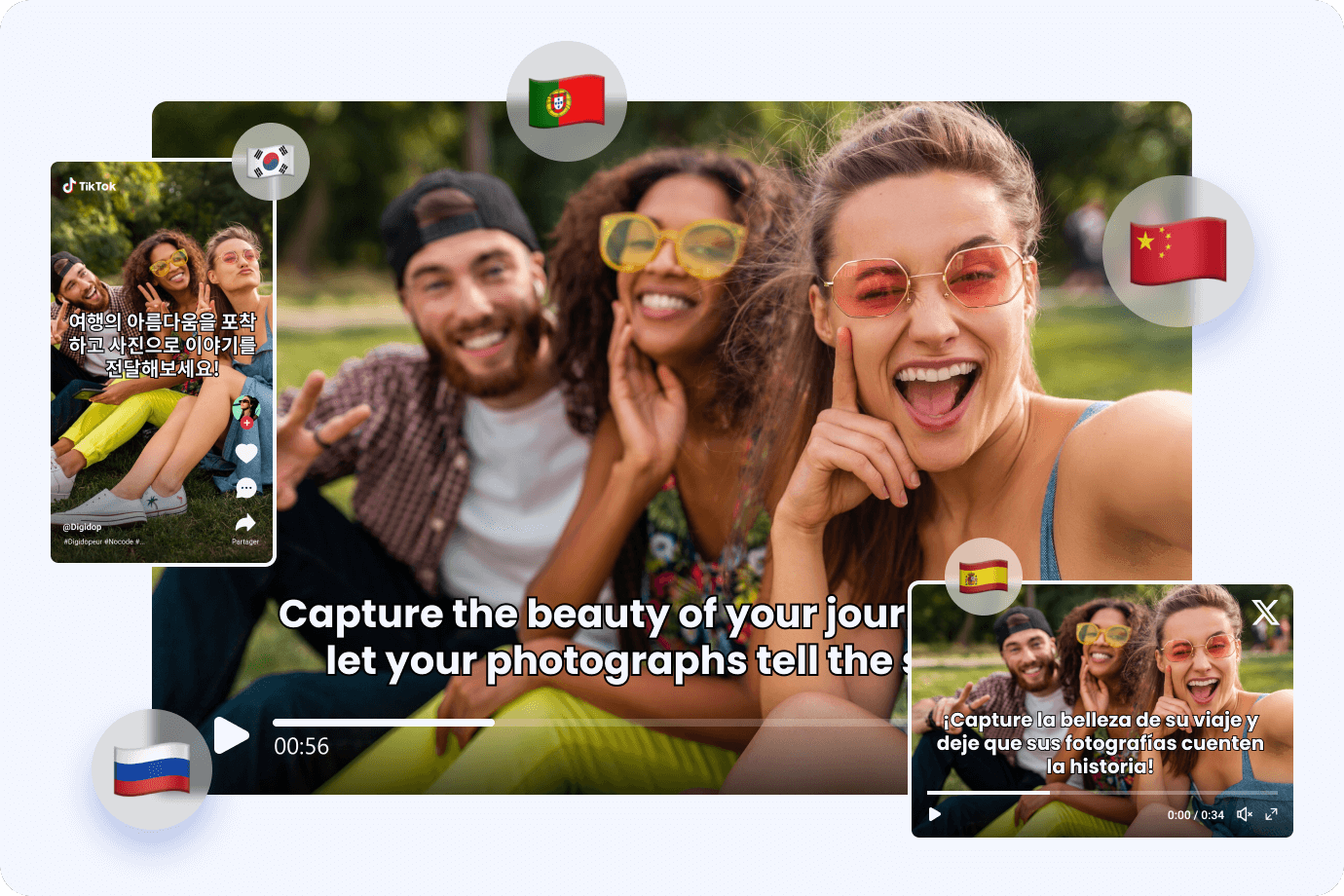
Wondershare Virbo is an AI video generator that covers multinational AI avatars, a plethora of natural voices, royalty-free assets, templates, and cross-platform support. So, whether you want a Hindi national spokesperson for your YouTube channel for media use, or you would like a Chinese national, there’s a choice for everyone.
All you need to have is text that you would like to be converted, and Virbo, with its extreme AI knowledge, would easily get the job done for you. So, let’s talk about some of the features that Virbo offers.
Steps to Translate Video English to Hindi
Vibro allows you to generate and translate videos for free, as long as you don’t reach your free quote. So, the first step is to sign up on Virbo for free. Go to the Official App Website and then select “Login”
- You can simply Login with Google or Create an account, based on your preference. And if you already have an account, then you can just login regularly.
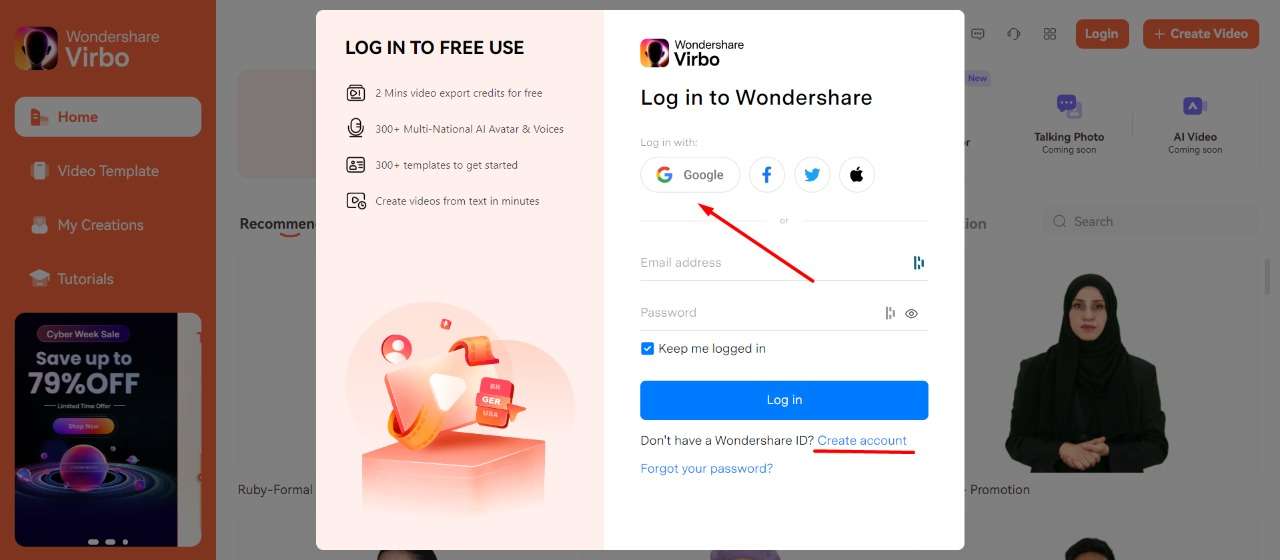
- Now you will reach the application page, and in the top right corner you will see the “Video Translator” tool. Click on that.
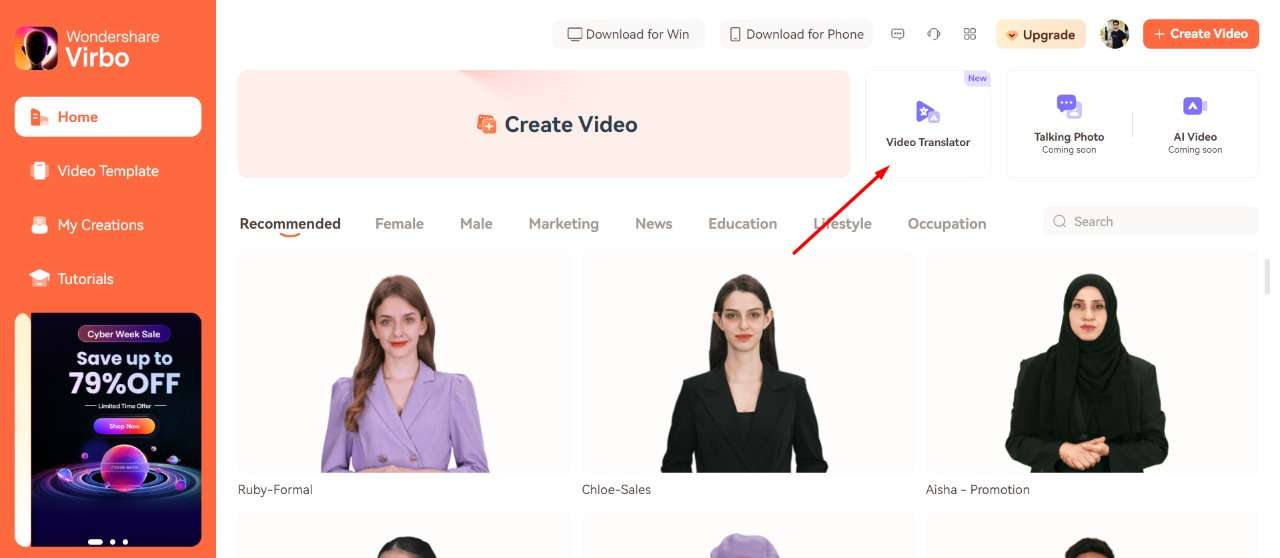
- The app will take you to the next tab. You can also download Virbo on your PC or mobile. Once you are on the Virbo app page, you can upload a video. The free version allows you to translate a video that is up to 2 minutes and 200MB.
Click to upload a video, select the original video language, which is English in our case, and select the target language to “Hindi.” Once you upload the file, select “Translate this video.”
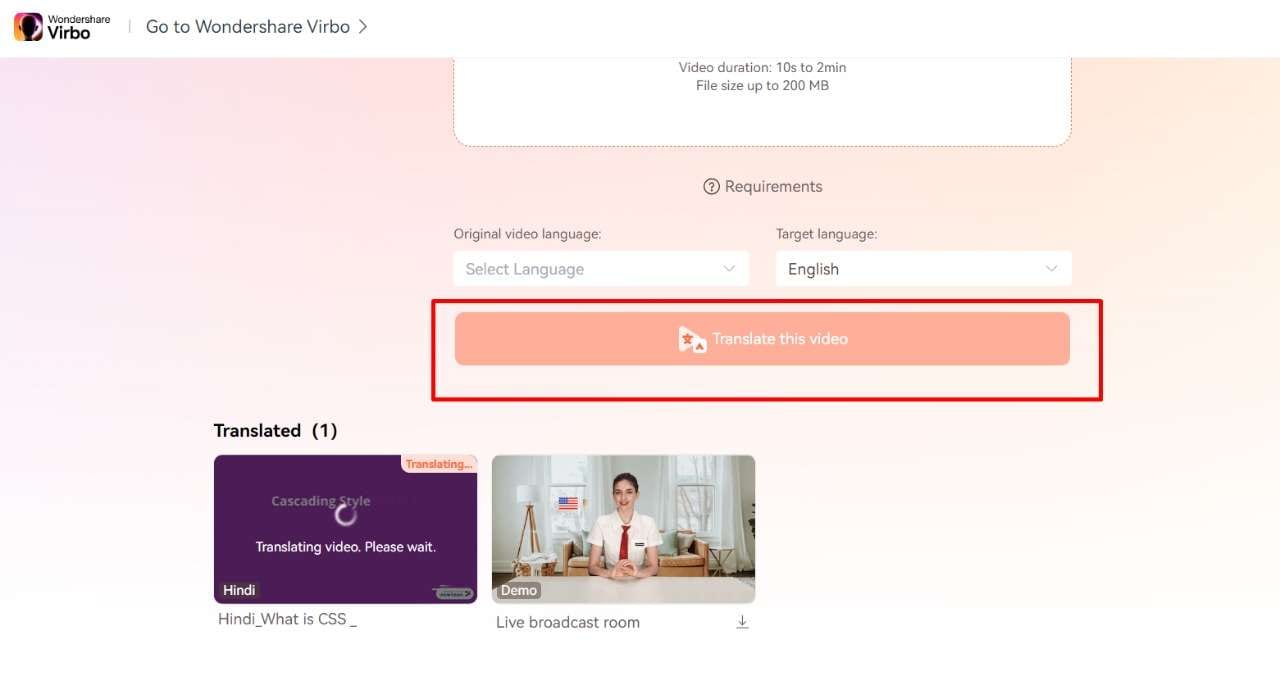
- Wait for the file to be translated, and you will have your own translated video. Now, you can enjoy translating as many videos as you like.
Key Features of Virbo Video Translator
1. AI Avatar

It is the era of the virtual avatars and Virbo absolutely delivers. It generates a virtual avatar for you that you can use to translate Hindi scripts to English with ease. Whether you are a news channel, a YouTuber, or just want to present something from Hindi to English, then using Virbo will be your best bet.
There are more than 300+ real human voices that are natural, you can engage with a broader audience, and the ethnicity choices are more, so no one is left out. All in all, the AI avatar feature of Virbo is revolutionary, making it one of the best Hindi video translators right now.
2. AI Voice
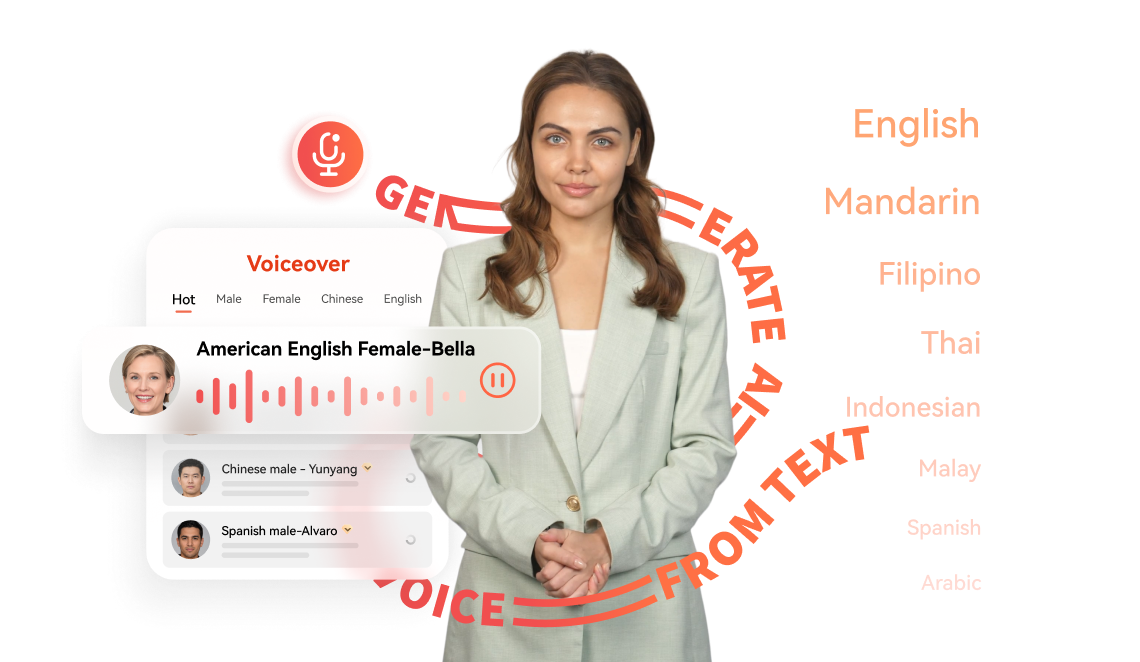
AI Voice is another strong point that goes hand in hand with AI Avatars. If you want to translate videos from Hindi to English and vice versa, you can use AI Voice from Virbo to create educational videos, marketing campaigns, customer interactions, and a lot more. The voice is human-like and uses the latest and greatest AI language models to do so.
3. AI Script Generator
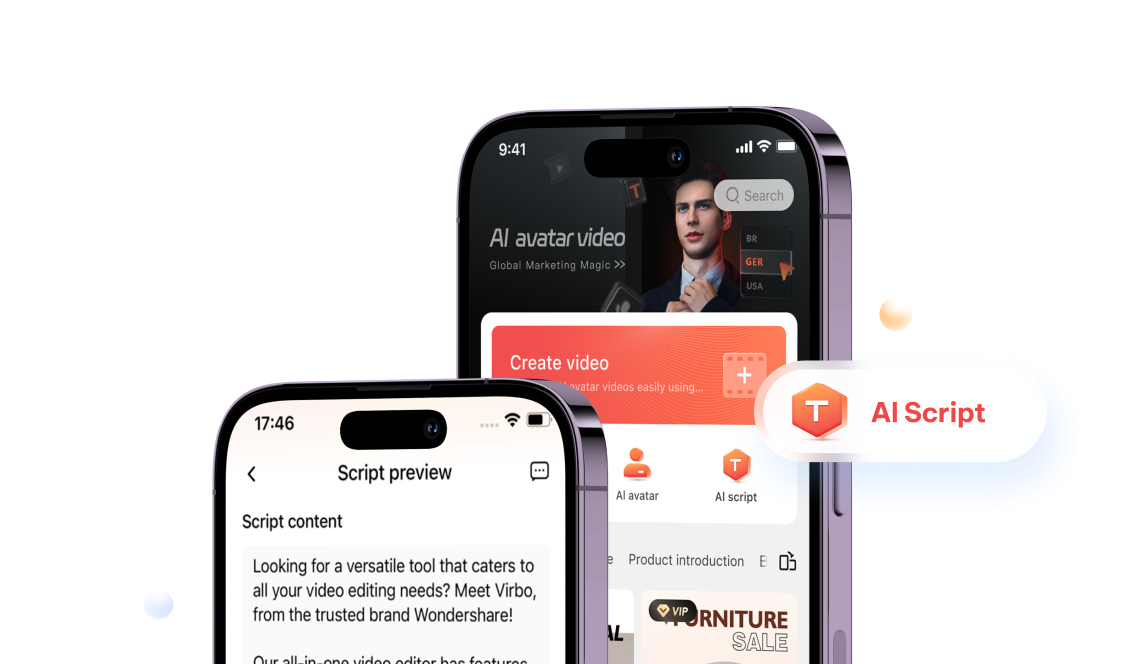
But what if you want to automate the whole process? Well, Vibro also has an AI script generator tool that enables you to use ChatGPT to get AI written scripts. But how will this help? Let’s say you are an educational institution who wants to teach your students some subject in Hindi. With Virbo, you can generate a script and then translate that script into Hindi, making education great again!
Pros of Virbo
- Amazing end results with AI voice and avatar generation tool.
- Video editing features are also included.
- Realistic and natural characters.
- All AI features make the video creation process simpler and effective.
- Powerful translation tool to make realistic videos in various languages.
- Comes with a video translator too that is simple to use.
Cons of Virbo
- Sometimes, there’s a slight lag.
Get Started Online Free Download
Part 2. Alternative 5 tools to translate Hindi video to English [Online]
1. Veed.io
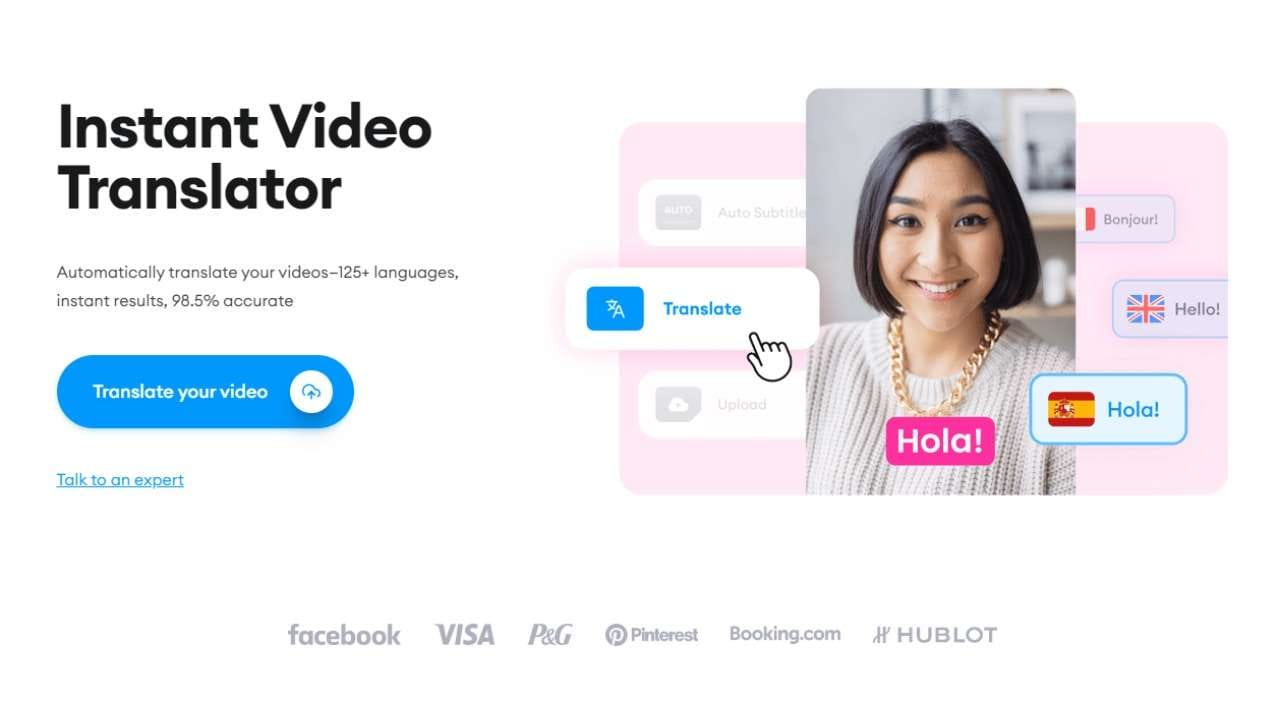
While there are a lot of Hindi-to-English translation tools on the market, you won’t find something like Veed . The reason is simple: it translates videos in 125+ languages with over 98.5% accuracy. Some of the biggest brands like Facebook, VISA, P&G, and Pinterest have also used Veed for their brand, which means Veed has an extremely good qualification for video translation.
Now, let’s talk about its features:
1. Download subtitles for efficient content repurposing:
While many video translation tools offer good features, Veed takes it to the next level by allowing you to download and edit subtitles according to your needs. You can also hard code or burn your subtitles to your videos permanently.
2. Accurate translations:
With over 98% accuracy in subtitles and translation, Veed can also be considered a great substitute for Google Translate and other tools. It is a great tool that also acts as a movie translator in Hindi apps, making it the best online app for translating movies.
Generate Engaging
AI Video in Minutes!
Easily convert text into professional spokesperson videos in over 120+ voices & languages in minutes.
2. Kapwing
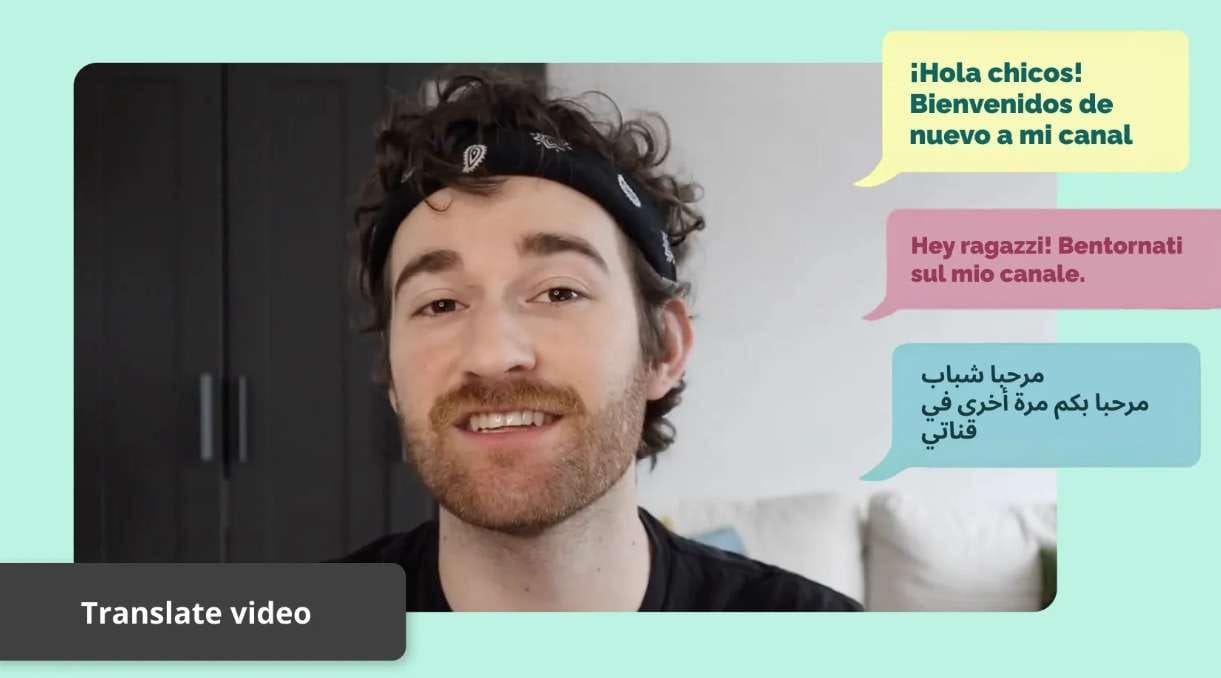
In the world of instant video translation tools, Kapwing takes the cake for being one of the most versatile tools out there. You can use the AI-powered tool in just a couple of minutes with a few clicks, and your work will be done easily.
You can instantly translate videos to and from 70+ languages, which saves hours of manually translating videos to reach a global audience. Here are some of the key features of Kapwing:
1. Automatic translations for videos, audio, and text:
Being an all-in-one translation tool, Kapwing can translate any audio file and even convert videos to text. It uses powerful AI subtitles, transcripts, and text-to-speech generation, so all aspects of content can be translated easily.
2. 70+ languages support:
With Kapwing, you can not only do Hindi video translation but it goes beyond that. With over 70+ languages, there’s a lot of flexibility in terms of which languages you can edit.
3. Flixier
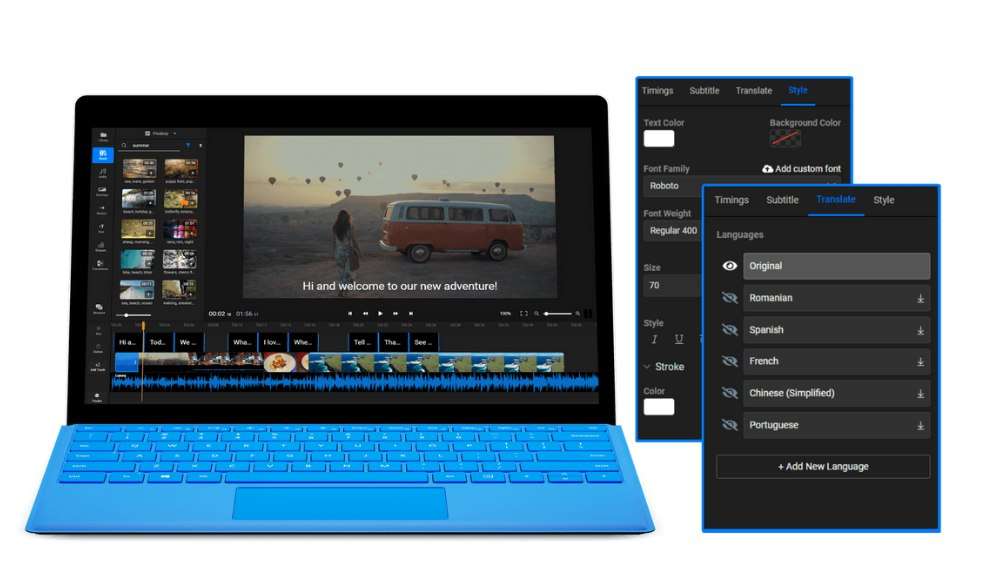
Flixier is one of the easiest software to use if you want a fast video language translator. While it doesn’t have a lot of language options, with 30 well-built languages, you can still get your content transformed into another language.
Flixier is also one of the few translators that allows subtitles translation in Hindi. However, there’s even more. The software is easy to use and doesn’t even require you to have an account unless you decide to go premium. Here are some of the features that it offers:
1. Video translation in browser:
With Flixier, you can easily translate your videos right within your browser. All you need is a good internet connection and a computer that would work well. The translation process is made even simpler because you don’t even have to make an account to use the software.
2. Free to use:
One of the biggest benefits of using Flixier is that it is a free video translator. Of course, as you use it more, you are going to have to buy the premium version, but if you want to try the software or get some simple projects done, then the free version will cater to your needs.
4. Rask AI

Rask AI is the future of video translations. It features over 130 languages, allowing the videos to resonate with viewers all around the globe. Moreover, it uses the latest AI tech to make sure that you get the best possible results every time you use its service.
But the user experience is where Rask AI takes the place of being one of the best Hindi-to-English video translators. All you need is to first upload your video or movie, select a language, and then translate according to your language choice. You will get the best possible result in this case.
Here are some of Rask AI’s features that make it so popular:
1. Automation made easier:
With Rask AI, automation is made easier as you don’t have to worry about taking out all that time to hire a translator, and even then, there’s a good chance of error. The AI-powered technology makes sure that the translation is done efficiently and effectively.
2. Language translation:
Rask AI is specifically made to translate language in video content. This way, no matter what business you have, you can reach a broader audience. The platform is easy to use, and anyone can learn it within a matter of minutes.
5. Typito
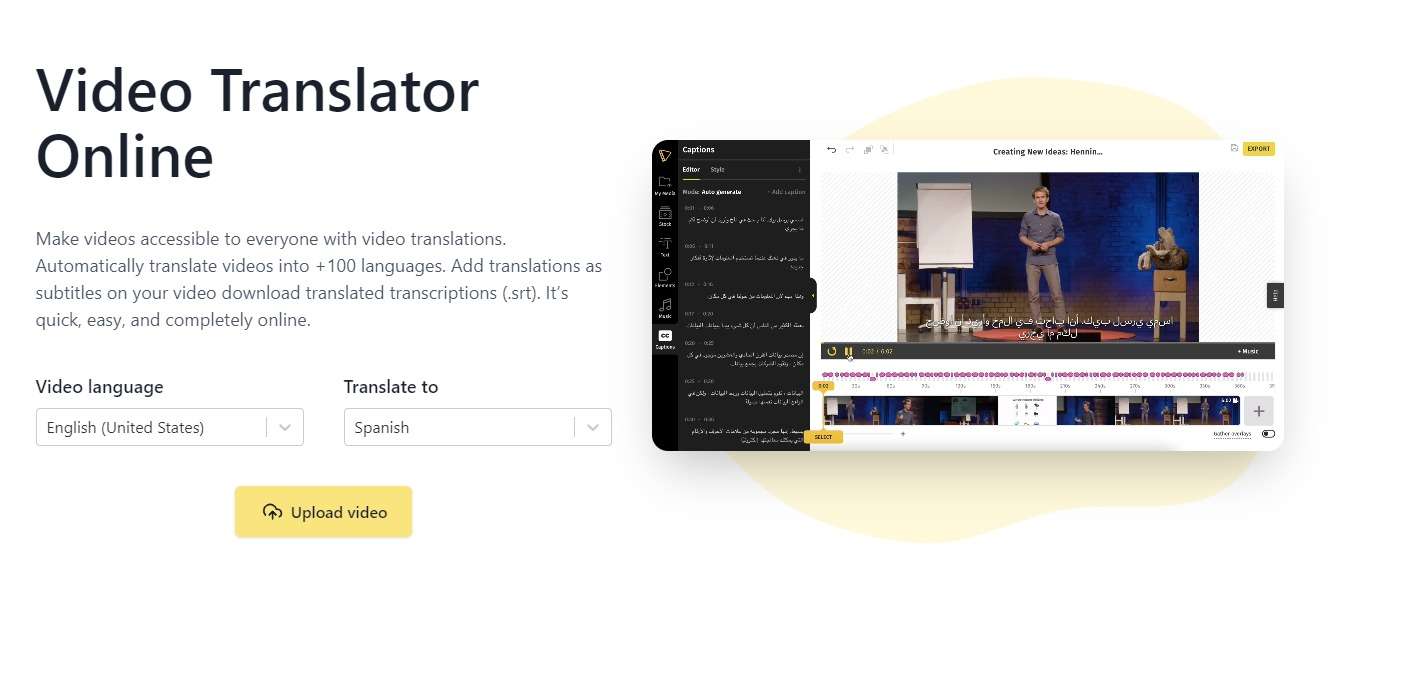
Typito offers one of the best Hindi video-to-English translations, but that’s not all. More than 500,000+ marketers, news agencies, business owners, and influencers are already using Typito to grow their audience to the next level.
Using this software is pretty simple. All you need to do is select the video language of your choice and select the desired translation language. As you upload the video, you need to wait for a few minutes for the online software to process. After some time, you are going to get your newly translated video right on your computer.
Here are some of the key features offered by Typito:
1. Translate into multiple languages:
Typito makes it easier for you to translate videos into multiple languages. The tool is designed to save you hours of your time while you simply get the most professionally translated video in a plethora of languages.
2. Translate YouTube videos:
One of the most popular features of Typito is that it allows you to translate your content far beyond what YouTube has to offer. It can burn your translated subtitles to appear the way you want. Moreover, you can also plate the subtitles on the top or bottom of your video.
3. Translate video to text:
While there are a lot of text-to-video translators, Typito goes beyond the regular stereotypes and also provides video-to-text translation with 95% accuracy. You can also click on the generated transcription to edit any words or phrases to your liking.
Part 3. Alternative 5 tools for Hindi video to English translation [Download]
1. Filmora
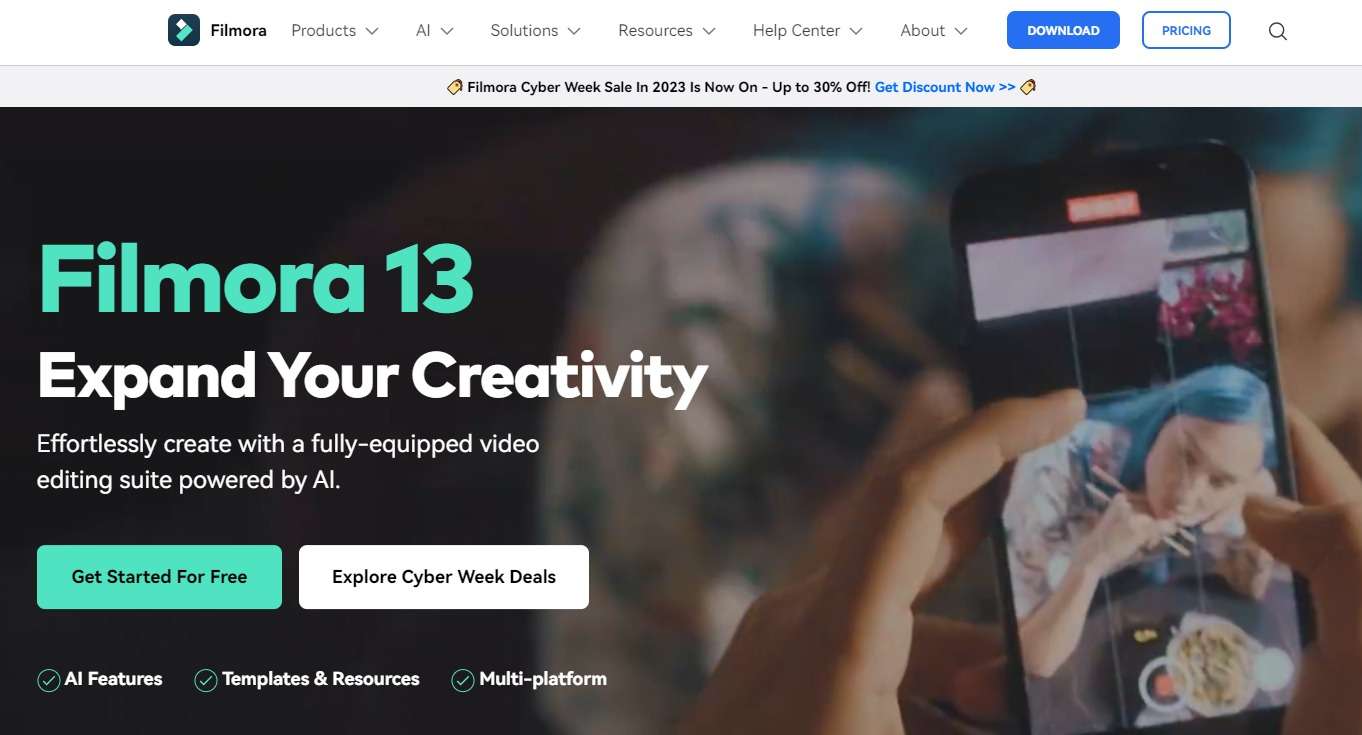
While Filmora has a broader focus, it can do free translations for your videos. You can use the video speech-to-text tool to make your videos more readable. The 1-click translator can translate your video into English, Chinese, Hindi, Spanish, French, Korean, Arabic, Russian, and over 26 languages.
If you want to emphasize or edit the subtitles, you can also use the built-in text editor to change the font, style, color, and everything.
1. Strong speech-to-text feature:
Fillmore has one of the strongest text-to-speech features that it uses to translate videos. Imagine having a video editor that does everything else for you. Filmora aims to be exactly that tool.
2. All-in-one editing tool:
The biggest benefit of using Filmora by far is the fact that it is more than just video translation software. It is mainly a video editing software with a plethora of AI tools that help in various parts of video production.
2. Streamr by VidToon
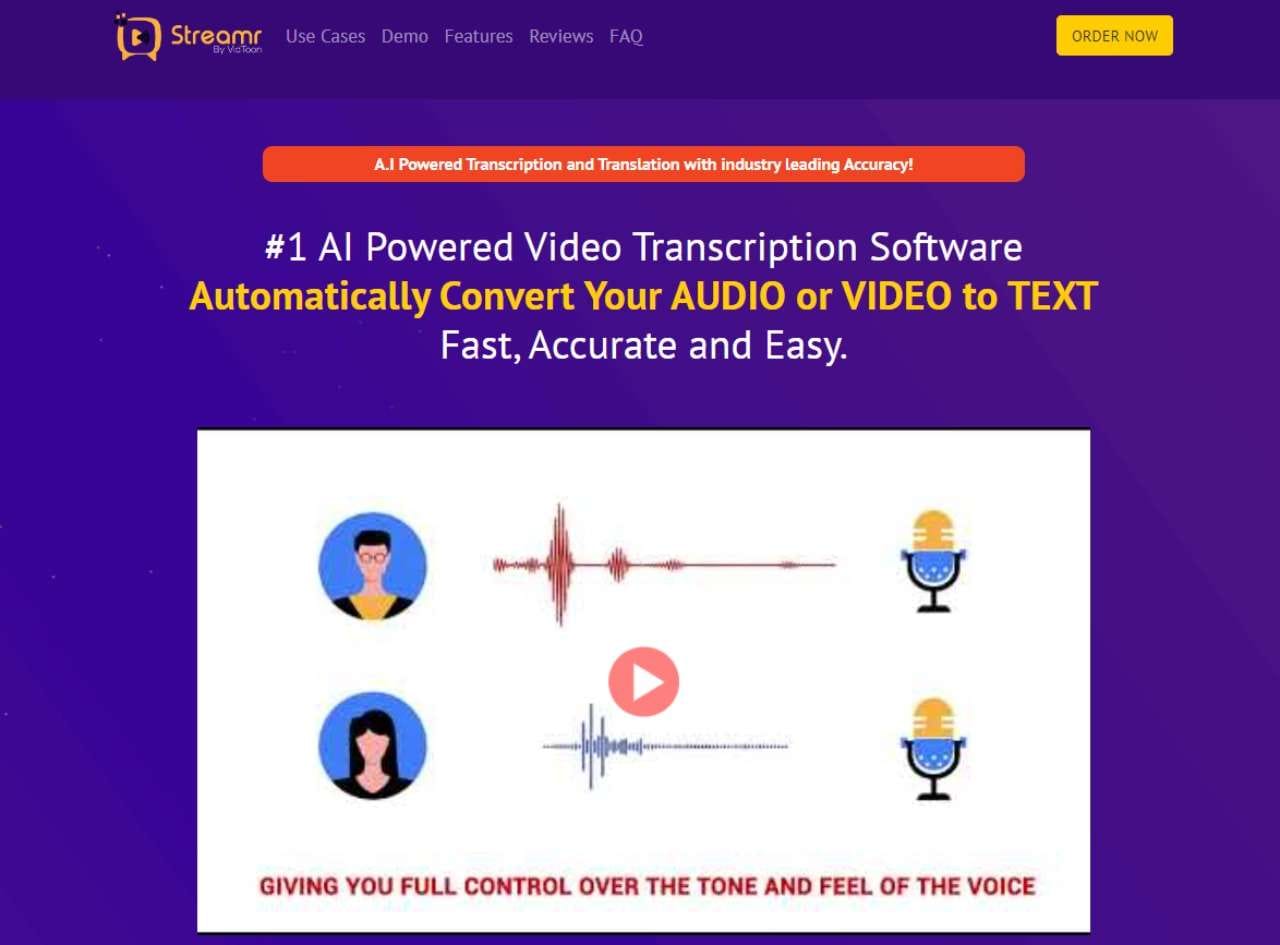
Streamr is a great tool to automatically convert your audio or video to text and beyond. However, it is a tool that is more focused on subtitles and gives you control over the text side of things.
So, if you ever want a video or audio to be converted into Hindi or English, then Streamr might be the best tool for you. It gives you so much control over the subtitle side of things that you would be amazed.
So, let’s discover some of these features:
1. Surge your conversions:
One of the best ways to tap the untapped markets is by using a tool like Streamr. It allows you to tap into the foreign market and multiply your video exposure by 75% all over the world.
2. Fully automated video:
With Streamr, you can make a fully automated video translation, Video Transcription, Audio Translation, Audio Transcription Software.
3. Vidscribe
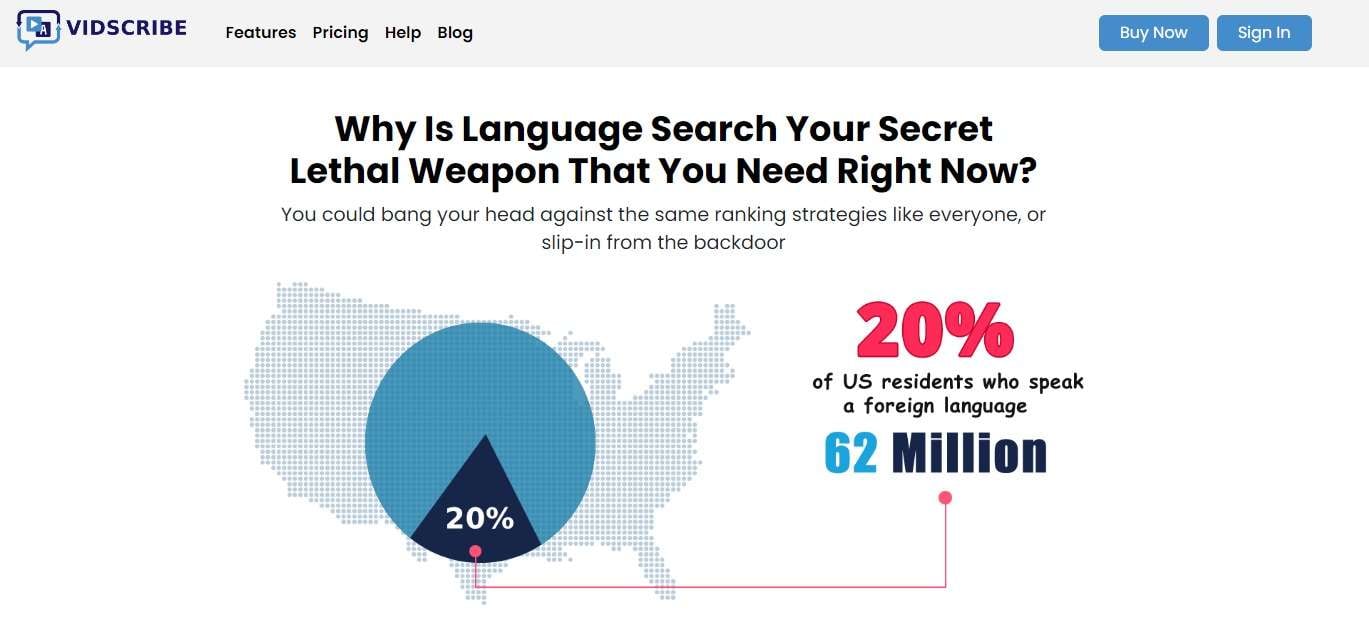
Vidscribe is an all-in-one tool with a plethora of features. However, one of its main features is to translate videos from 100s of languages, which is one of the best ways to reach a global audience.
Vidscribe can be downloaded to your PC, but it is a paid tool with features that make translation easier and more effective. Here are some of the features it offers:
1. Global reach:
Vidscribe is ideal for YouTube channels, blogs, and other media companies that want to take over the digital world. It has some of the most advanced tools to translate and then track those metrics. If you want a Hindi-to-English or English-to-Hindi translator, then Vidscribe would be ideal.
2. Money back guarantee:
With VidScribe, you also get a 30-day money-back guarantee. You should know that most online tools don’t work on this model. Since VidScribe is more of a translation and SEO tool, it provides you with a lot of flexibility and options.
4. VSCAT

But if you’re looking to translate Hindi to English and vice versa, then a classic tool like VSCAT would be your friend. It is a powerful tool that lets you translate and automatically create video subtitles in multiple languages.
Yes, it does support Hindi, and it does its job perfectly. Here are some of the key features of VSCAT:
1. Advance technology:
VSCAT uses advanced technology like OpenAI’s whisper to help you in the translation of these videos. It is a tool that has proven to be a popular translator time and again. Moreover, with VSCAT, you can enable yourself to provide content that would convert.
2. Easy-to-use:
While VSCAT looks like it’s complex, it’s fairly simple to use. All the features are well-laid out, and you can make any settings you want according to your liking. This means that aside from doing the translation, you can also customize the software according to your liking.
5. Speechify
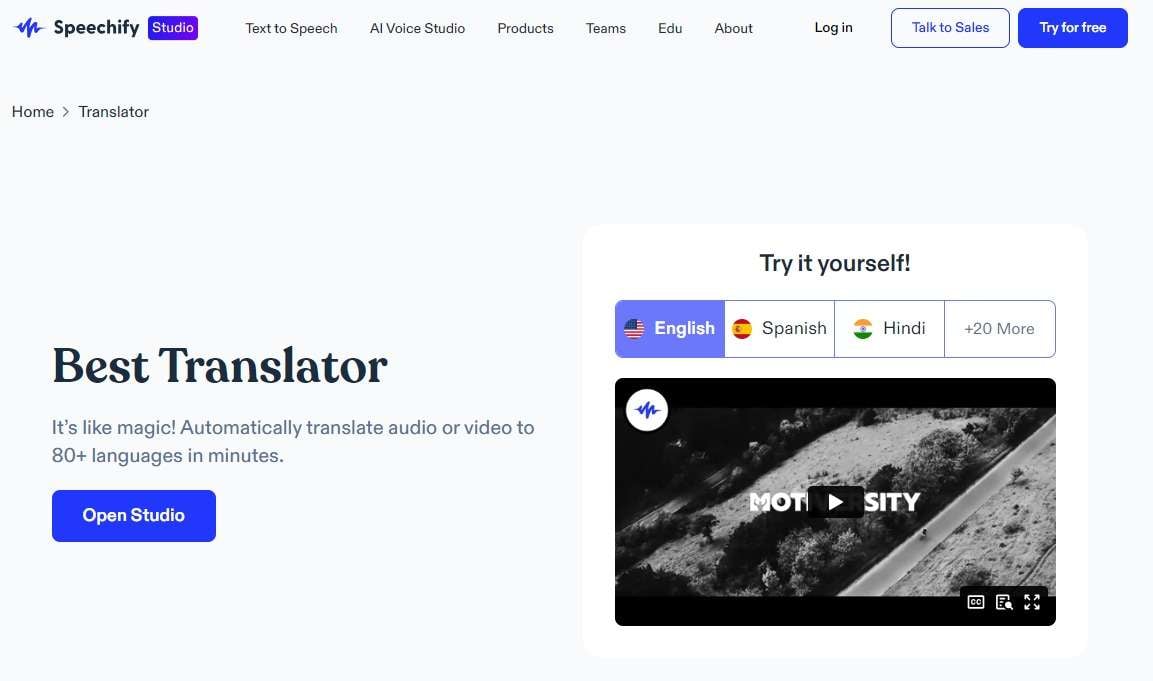
One of the best translation tools for Hindi to English is Speechify . While the software doesn’t have an app on Windows, you can use it on both Android and iOS. For Windows users, they can easily leverage the Chrome extension or the online tool to translate videos.
Here are a few features that it provides:
1. 80+ language support:
Speechify works like magic. It supports 80+ languages that you can use to automatically translate video or audio. There’s no need for expensive processes or employees, and you can instantly get the desired results according to your liking.
2. Realistic AI voices:
The software does give you extremely good AI voices. They not only sound like humans but everything from the accent and the dialect to everything; you can rely on Speechify to deliver a pristine quality of voiceovers.
Part 4. F.A.Q about Hindi Video Translator
01 How can I translate a Hindi video to English?
To translate a Hindi video into English, you need AI-centric video translation software. We have mentioned a lot of tools above. If you are looking for the perfect tool to translate Hindi to English or English to Hindi, then you should use a tool like Veed.io or Virbo for easy and efficient translation.
02 How to convert Hindi text to English
One of the best ways to convert Hindi text to English is by using a tool like Streamr or Kapwing. Both have great built-in features that allow for easy Hindi text-to-English conversion. Whether you are looking for a Hindi video to English translation tool or something that would translate text, you can find a variety of tools that would help you in achieving this. We have also mentioned them based on the features and expertise of each tool and how they work.
03 How can I translate video words?
To translate video words, you need to use a video-to-text translation tool. In the description above, we have mentioned many tools that can help you achieve the same. If you want to translate Hindi video to English or simply the words, you should aim for a tool that is specifically going to specialize in translating words.
Complete Guide of Top Video Language Translators
The fusion of diverse cultures and languages has become a hallmark of innovation. At the forefront of this linguistic revolution are video language translators, powerful tools reshaping how we perceive and engage with multimedia. This guide is a gateway into the transformative realm of video translation, where the convergence of technology and language transcends barriers. Our exploration will unveil the top 8 video language translators, each a beacon in the quest for seamless, cost-free, and automated ways to translate video content.
Part 1: Rise of Video Language Translators and Its Impact on Innovative World
In the ever-expanding digital frontier, the ascent of video language translators marks a paradigm shift in how information transcends linguistic boundaries. This section unravels the transformative impact of these tools, delving into their role as catalysts for innovation in a globally interconnected landscape.
01 Redefining Cross-Cultural Communication
As the world becomes a digital tapestry woven with diverse languages and cultures, video language translators emerge as key facilitators, breaking down the barriers that once limited the reach of multimedia content. Explore how these tools redefine the landscape of cross-cultural communication, enabling seamless interaction and understanding.
02 Enabling Globalized Content Creation
The impact of video language translators extends beyond mere translation, fostering a truly globalized and inclusive digital sphere where ideas flow seamlessly. Dive into how these tools empower content creators to transcend linguistic constraints, unleashing a wave of creativity that resonates with audiences around the world.
03 Bridging Communities through Shared Narratives
Innovative world-building involves more than technology; it’s about fostering connections and understanding. Discover how video language translators act as bridges between communities, enabling individuals and businesses to share their stories, ideas, and innovations with a worldwide audience.
04 Empowering Collaboration and Knowledge Exchange
As we explore the impacts, recognize how these translators empower collaboration and knowledge exchange on a global scale. They facilitate a free flow of information, transcending language barriers and enabling individuals from diverse backgrounds to contribute to the collective pool of global knowledge.
05 Shaping a Future of Inclusivity
Join us in understanding the profound influence these translators wield in shaping our innovative world, where the fusion of languages not only facilitates communication but also propels us into a future where collaboration and understanding know no linguistic bounds. Explore how these tools contribute to a future marked by inclusivity, where the richness of diverse languages enhances the global exchange of ideas.
Part 2: Explore Top 7 Translators to Translate Video Free
In this part, we will explore the top 8 video translators that stand out for their ability to seamlessly translate videos without putting a dent in your budget. From user-friendly interfaces to robust language support, each of these tools brings something unique to the table. Join us as we navigate the features and functionalities that make these translators the go-to choices for those seeking efficient and cost-free ways to translate video content.
1. Wondershare Virbo
In the fast-paced world of digital content creation, the ability to communicate with a global audience is a game-changer. Virbo, a cutting-edge video language translator app, steps into this arena, offering content creators a dynamic platform to transcend linguistic barriers and connect with viewers worldwide. As we delve into Virbo, let’s explore its unique features, advantages, and considerations.

Get Started Online Free Download
Features
- Whether you’re a seasoned creator or just starting, its user-friendly layout ensures a smooth and efficient experience.
- Its advanced speech recognition ensures accurate and nuanced translations, enhancing the audiovisual appeal of your content.
- It ensures that you can translate content dynamically as you create, providing instant feedback on how your video will resonate with a global audience.
Pros
- Its intuitive design ensures that creators of all levels can navigate the app seamlessly.
- It’s a versatile tool for connecting with diverse audiences.
- It ensures a secure environment for content creation and translation.
Cons
- It offers an offline mode; some features may be limited without an internet connection.
- For new users, the array of features may require some learning.
2. Google Translator
Standing as a beacon of versatility, Google Translate emerges as a leading video audio translator app. It supports a multitude of languages. It goes beyond traditional translation methods, offering real-time translation through the camera. Whether your content is spoken or written, it provides a user-friendly solution for diverse video translation requirements.

Features
- It boasts an extensive language repertoire, supporting a vast array of languages, making it a versatile tool for global content translation.
- It excels in translating written text. Its text translation capabilities are robust and cover a wide range of linguistic nuances.
- A standout feature is the real-time camera translation, enabling users to translate text in images or videos instantly through their device’s camera.
Pros
- It has a user-friendly interface, making it accessible for users with varying levels of technological expertise.
- It eliminates financial barriers, allowing a broad user base to benefit from its language translation features.
- It regularly updates and improves its translation algorithms.
Cons
- It may still face challenges in accurately translating complex or context-specific phrases.
- Its certain features depend on an internet connection, limiting functionality in offline scenarios.
3. Papago
Hailing from South Korea, Papago has garnered international acclaim for its accuracy and efficiency. This app supports real-time translation for both text and voice, ensuring that language is no longer a barrier in everyday scenarios or critical business meetings. Papago’s commitment to precision positions it as a reliable companion in the realm of global communication.

Features
- It accurately capturing spoken language and converting it into text, providing users with a seamless and efficient way to communicate across language barriers.
- It is known for its accuracy and efficiency in translating both text and voice.
- It provides a comprehensive range of supported languages, catering to diverse user needs.
Pros
- It incorporates human expertise, adding a nuanced touch to translations that goes beyond literal meaning
- It brings a unique perspective and precision to its translations.
- It offers offline functionality.
Cons
- It may be less known globally compared to some other translation apps.
- The interface may be perceived as more complex for users seeking a simpler design
4. Microsoft Translator
In the world of text and voice translation, Microsoft Translator takes the spotlight. This free and accessible tool caters to content creators seeking seamless translation for spoken content in their videos. Its user-friendly interface and wide language support make it a go-to choice for creators of

Features
- It boasts an extensive language portfolio, covering a diverse range of languages to facilitate global communication.
- It excels in text and voice translations, providing users with flexibility in how they choose to communicate across language barriers.
- It ensures accessibility for users with varying levels of technical expertise.
Pros
- It is recognized for its accurate speech recognition.
- It allows users to translate content directly within familiar Office tools.
- It enables multiple users to work together on translating content.
Cons
- It may face challenges in achieving the same level of fluency.
- Some advanced features may depend on a consistent internet connection.
5. SayHi
Venturing into the realm of voice translation, SayHi captures attention with its real-time translation capabilities. Ideal for creators looking for video language translator app to auto translate video in different languages, it provides a seamless experience for translating spoken words, enriching the audiovisual dimension of your videos.

Features
- It allows users to engage in live conversations and create dynamic multilingual content effortlessly.
- It supports a wide array of languages, enabling users to translate spoken words seamlessly across diverse linguistic contexts.
- It features a user-friendly interface, making it accessible for users of various language proficiency levels and technical expertise.
Pros
- It allows users to perform translations without the need for a continuous internet connection.
- It enables users to store commonly used phrases for quick and easy access during conversations.
- It enhances the precision of translations for specific regional or contextual language nuances.
Cons
- It may face challenges in accurately capturing the nuanced complexities.
- Some advanced features may depend on an internet connection.
6. Veed.io
In the realm of online video language translator, Veed stands out as a comprehensive platform that goes beyond the ordinary. With its integrated automatic subtitle generator and translator, it brings a new level of efficiency and creativity to content creation.

Features
- It excels in simplifying the subtitle creation process through its automatic generator, significantly reducing the time and effort required for manual transcription.
- The platform stands out with its translation feature, enabling creators to connect with a global audience by converting subtitles into various languages, promoting inclusivity.
- It offers a seamless integration of video editing tools, allowing users to enhance their content within the same platform, eliminating the need for multiple applications.
Pros
- It enables a smooth and efficient content creation process, saving time and effort.
- Its interface is user-friendly, ensuring a positive experience for creators at various skill levels.
- It allows users to access their projects from anywhere with an internet connection.
Cons
- It relies on a stable internet connection.
- It may not provide the depth of advanced editing tools.
7. Amara
Diving into the collaborative side of video language translator, Amara shines as a community-driven platform for creating and translating subtitles. This open approach allows content creators to crowd source translations, ensuring accuracy and inclusivity in the subtitles for their videos.

Features
- Amara is a pioneer in collaborative subtitle creation, allowing multiple users to contribute to the translation and refinement of subtitles for a video.
- It supports a variety of languages, facilitating the creation of subtitles for videos targeted at diverse global audiences.
- It embraces a crowd sourced approach to translation, enabling communities to work together on translating content accurately and efficiently.
Pros
- It ensures a diverse set of perspectives for accurate and contextually relevant subtitles.
- It makes video content more inclusive for audiences with hearing impairments.
- It supports various subtitle formats, providing flexibility for content creators.
Cons
- Users unfamiliar with the platform may experience a learning curve.
- It primarily focuses on subtitle creation.
Conclusion
In conclusion, the availability of top video language translators has transformed the way we engage with content across linguistic boundaries. Whether you are a student, a professional, or a casual viewer, these tools empower you to access a wealth of information in your preferred language. As technology continues to advance, the impact of video language translators on our interconnected world is only set to grow, fostering a global community where communication knows no linguistic limits.
The fusion of diverse cultures and languages has become a hallmark of innovation. At the forefront of this linguistic revolution are video language translators, powerful tools reshaping how we perceive and engage with multimedia. This guide is a gateway into the transformative realm of video translation, where the convergence of technology and language transcends barriers. Our exploration will unveil the top 8 video language translators, each a beacon in the quest for seamless, cost-free, and automated ways to translate video content.
Part 1: Rise of Video Language Translators and Its Impact on Innovative World
In the ever-expanding digital frontier, the ascent of video language translators marks a paradigm shift in how information transcends linguistic boundaries. This section unravels the transformative impact of these tools, delving into their role as catalysts for innovation in a globally interconnected landscape.
01 Redefining Cross-Cultural Communication
As the world becomes a digital tapestry woven with diverse languages and cultures, video language translators emerge as key facilitators, breaking down the barriers that once limited the reach of multimedia content. Explore how these tools redefine the landscape of cross-cultural communication, enabling seamless interaction and understanding.
02 Enabling Globalized Content Creation
The impact of video language translators extends beyond mere translation, fostering a truly globalized and inclusive digital sphere where ideas flow seamlessly. Dive into how these tools empower content creators to transcend linguistic constraints, unleashing a wave of creativity that resonates with audiences around the world.
03 Bridging Communities through Shared Narratives
Innovative world-building involves more than technology; it’s about fostering connections and understanding. Discover how video language translators act as bridges between communities, enabling individuals and businesses to share their stories, ideas, and innovations with a worldwide audience.
04 Empowering Collaboration and Knowledge Exchange
As we explore the impacts, recognize how these translators empower collaboration and knowledge exchange on a global scale. They facilitate a free flow of information, transcending language barriers and enabling individuals from diverse backgrounds to contribute to the collective pool of global knowledge.
05 Shaping a Future of Inclusivity
Join us in understanding the profound influence these translators wield in shaping our innovative world, where the fusion of languages not only facilitates communication but also propels us into a future where collaboration and understanding know no linguistic bounds. Explore how these tools contribute to a future marked by inclusivity, where the richness of diverse languages enhances the global exchange of ideas.
Part 2: Explore Top 7 Translators to Translate Video Free
In this part, we will explore the top 8 video translators that stand out for their ability to seamlessly translate videos without putting a dent in your budget. From user-friendly interfaces to robust language support, each of these tools brings something unique to the table. Join us as we navigate the features and functionalities that make these translators the go-to choices for those seeking efficient and cost-free ways to translate video content.
1. Wondershare Virbo
In the fast-paced world of digital content creation, the ability to communicate with a global audience is a game-changer. Virbo, a cutting-edge video language translator app, steps into this arena, offering content creators a dynamic platform to transcend linguistic barriers and connect with viewers worldwide. As we delve into Virbo, let’s explore its unique features, advantages, and considerations.

Get Started Online Free Download
Features
- Whether you’re a seasoned creator or just starting, its user-friendly layout ensures a smooth and efficient experience.
- Its advanced speech recognition ensures accurate and nuanced translations, enhancing the audiovisual appeal of your content.
- It ensures that you can translate content dynamically as you create, providing instant feedback on how your video will resonate with a global audience.
Pros
- Its intuitive design ensures that creators of all levels can navigate the app seamlessly.
- It’s a versatile tool for connecting with diverse audiences.
- It ensures a secure environment for content creation and translation.
Cons
- It offers an offline mode; some features may be limited without an internet connection.
- For new users, the array of features may require some learning.
2. Google Translator
Standing as a beacon of versatility, Google Translate emerges as a leading video audio translator app. It supports a multitude of languages. It goes beyond traditional translation methods, offering real-time translation through the camera. Whether your content is spoken or written, it provides a user-friendly solution for diverse video translation requirements.

Features
- It boasts an extensive language repertoire, supporting a vast array of languages, making it a versatile tool for global content translation.
- It excels in translating written text. Its text translation capabilities are robust and cover a wide range of linguistic nuances.
- A standout feature is the real-time camera translation, enabling users to translate text in images or videos instantly through their device’s camera.
Pros
- It has a user-friendly interface, making it accessible for users with varying levels of technological expertise.
- It eliminates financial barriers, allowing a broad user base to benefit from its language translation features.
- It regularly updates and improves its translation algorithms.
Cons
- It may still face challenges in accurately translating complex or context-specific phrases.
- Its certain features depend on an internet connection, limiting functionality in offline scenarios.
3. Papago
Hailing from South Korea, Papago has garnered international acclaim for its accuracy and efficiency. This app supports real-time translation for both text and voice, ensuring that language is no longer a barrier in everyday scenarios or critical business meetings. Papago’s commitment to precision positions it as a reliable companion in the realm of global communication.

Features
- It accurately capturing spoken language and converting it into text, providing users with a seamless and efficient way to communicate across language barriers.
- It is known for its accuracy and efficiency in translating both text and voice.
- It provides a comprehensive range of supported languages, catering to diverse user needs.
Pros
- It incorporates human expertise, adding a nuanced touch to translations that goes beyond literal meaning
- It brings a unique perspective and precision to its translations.
- It offers offline functionality.
Cons
- It may be less known globally compared to some other translation apps.
- The interface may be perceived as more complex for users seeking a simpler design
4. Microsoft Translator
In the world of text and voice translation, Microsoft Translator takes the spotlight. This free and accessible tool caters to content creators seeking seamless translation for spoken content in their videos. Its user-friendly interface and wide language support make it a go-to choice for creators of

Features
- It boasts an extensive language portfolio, covering a diverse range of languages to facilitate global communication.
- It excels in text and voice translations, providing users with flexibility in how they choose to communicate across language barriers.
- It ensures accessibility for users with varying levels of technical expertise.
Pros
- It is recognized for its accurate speech recognition.
- It allows users to translate content directly within familiar Office tools.
- It enables multiple users to work together on translating content.
Cons
- It may face challenges in achieving the same level of fluency.
- Some advanced features may depend on a consistent internet connection.
5. SayHi
Venturing into the realm of voice translation, SayHi captures attention with its real-time translation capabilities. Ideal for creators looking for video language translator app to auto translate video in different languages, it provides a seamless experience for translating spoken words, enriching the audiovisual dimension of your videos.

Features
- It allows users to engage in live conversations and create dynamic multilingual content effortlessly.
- It supports a wide array of languages, enabling users to translate spoken words seamlessly across diverse linguistic contexts.
- It features a user-friendly interface, making it accessible for users of various language proficiency levels and technical expertise.
Pros
- It allows users to perform translations without the need for a continuous internet connection.
- It enables users to store commonly used phrases for quick and easy access during conversations.
- It enhances the precision of translations for specific regional or contextual language nuances.
Cons
- It may face challenges in accurately capturing the nuanced complexities.
- Some advanced features may depend on an internet connection.
6. Veed.io
In the realm of online video language translator, Veed stands out as a comprehensive platform that goes beyond the ordinary. With its integrated automatic subtitle generator and translator, it brings a new level of efficiency and creativity to content creation.

Features
- It excels in simplifying the subtitle creation process through its automatic generator, significantly reducing the time and effort required for manual transcription.
- The platform stands out with its translation feature, enabling creators to connect with a global audience by converting subtitles into various languages, promoting inclusivity.
- It offers a seamless integration of video editing tools, allowing users to enhance their content within the same platform, eliminating the need for multiple applications.
Pros
- It enables a smooth and efficient content creation process, saving time and effort.
- Its interface is user-friendly, ensuring a positive experience for creators at various skill levels.
- It allows users to access their projects from anywhere with an internet connection.
Cons
- It relies on a stable internet connection.
- It may not provide the depth of advanced editing tools.
7. Amara
Diving into the collaborative side of video language translator, Amara shines as a community-driven platform for creating and translating subtitles. This open approach allows content creators to crowd source translations, ensuring accuracy and inclusivity in the subtitles for their videos.

Features
- Amara is a pioneer in collaborative subtitle creation, allowing multiple users to contribute to the translation and refinement of subtitles for a video.
- It supports a variety of languages, facilitating the creation of subtitles for videos targeted at diverse global audiences.
- It embraces a crowd sourced approach to translation, enabling communities to work together on translating content accurately and efficiently.
Pros
- It ensures a diverse set of perspectives for accurate and contextually relevant subtitles.
- It makes video content more inclusive for audiences with hearing impairments.
- It supports various subtitle formats, providing flexibility for content creators.
Cons
- Users unfamiliar with the platform may experience a learning curve.
- It primarily focuses on subtitle creation.
Conclusion
In conclusion, the availability of top video language translators has transformed the way we engage with content across linguistic boundaries. Whether you are a student, a professional, or a casual viewer, these tools empower you to access a wealth of information in your preferred language. As technology continues to advance, the impact of video language translators on our interconnected world is only set to grow, fostering a global community where communication knows no linguistic limits.
How To Use CapCut Translate to Transform Video Content
Accurate and efficient video translations are essential for reaching global audiences. They bridge linguistic barriers. Translations open doors to diverse viewership and amplify your content’s impact. The article delves into two leading tools for enhancing translations:CapCut Translate and Wondershare Virbo.
The page provides an in-depth comparison and a handy guide for using each tool’s capabilities. Whether it’s auto-translating subtitles or language nuances, these platforms streamline the localization process. Each app ensures your message resonates across borders. Explore the guide for insights and tips to elevate your video content’s reach and relevance. Read on to learn more.

Part 1. CapCut Translate: An Overview
CapCut Translate Subtitles is a nifty app that helps you make accurate and efficient translations of video content. With its intuitive interface, the app bridges language barriers and allows you to reach a diverse audience. Here are its key features of transcribe video to text by Capcut:

- Video-to-text translation
CapCut Translate enables you to translate spoken or written content within videos into text. The auto-translation of CapCut helps create accurate subtitles or transcripts in many languages. It enhances accessibility and comprehension for viewers.
- Multilingual subtitle translation
You can translate subtitles into various languages. The app ensures that your content is accessible to global audiences. It supports a wide range of languages. It’s a versatile tool for international outreach and engagement.
- Customizable subtitles
CapCut offers flexibility in subtitle customization. It allows you to adjust font styles, sizes, colors, and positions. You can suit your preferences or branding requirements. The customization enhances the visual appeal and readability of subtitles, enhancing viewer engagement.
Use Cases
CapCut is a valuable tool for breaking down language barriers. Here are the platform’s different use cases:
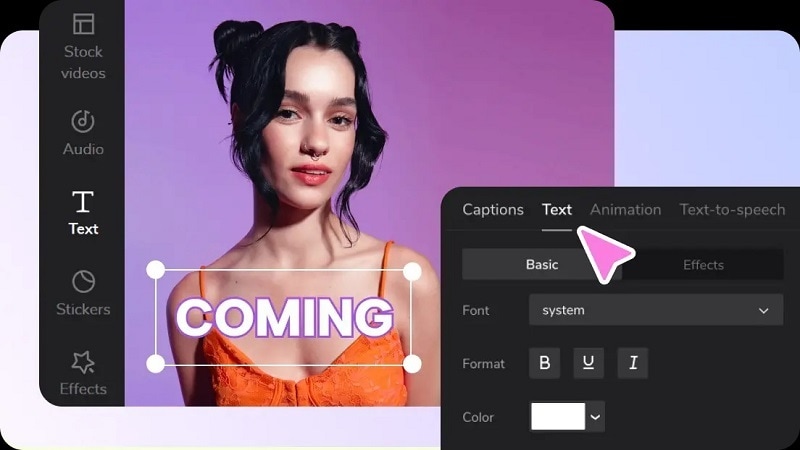
- Global marketing campaigns
CapCut Translate is ideal for businesses conducting international marketing campaigns. By translating videos or ads, companies can communicate with diverse target audiences. It maximizes brand visibility and engagement on a global scale.
- Education for special schools
The app can be used in educational settings. It can be useful for students with linguistic or hearing impairments. Teachers can create translated video lessons or instructional materials with subtitles. It ensures that all students can access and comprehend the content regardless of language barriers.
- International conferences
CapCut helps seamless communication at international conferences or events. It provides real-time translation with a few clicks. The app ensures that participants can engage in the proceedings and discussions.
How To Use Auto Translation With CapCut
Follow the steps below to take advantage of CapCut Translate’s subtitle translator for your videos.
- Step 1: Download and install the application to your computer. Launch the app. Upload the video from your computer to the platform’s interface. You can also upload via Myspace, Google Drive, Dropbox, or QR code.
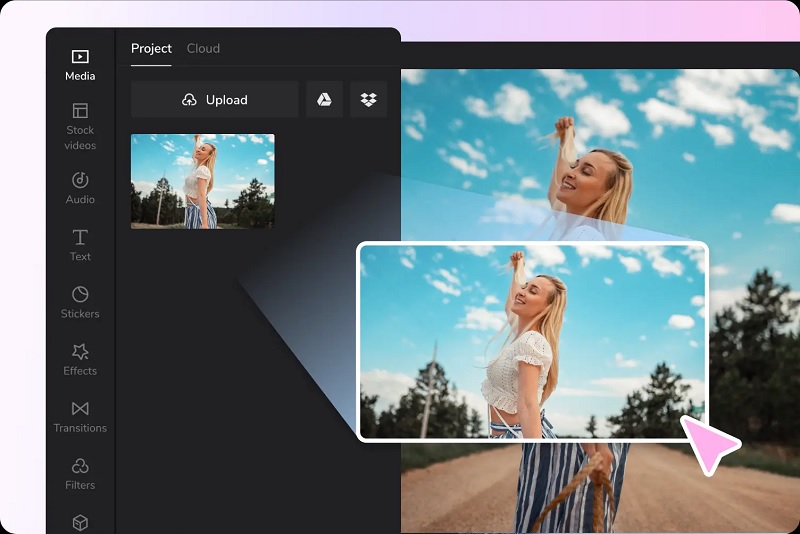
- Step 2: Once the video is uploaded, the app will detect the spoken language in your video. Next, click on Captions > Auto captions > Generate. Next, wait for the CapCut auto caption generator to process the translation.
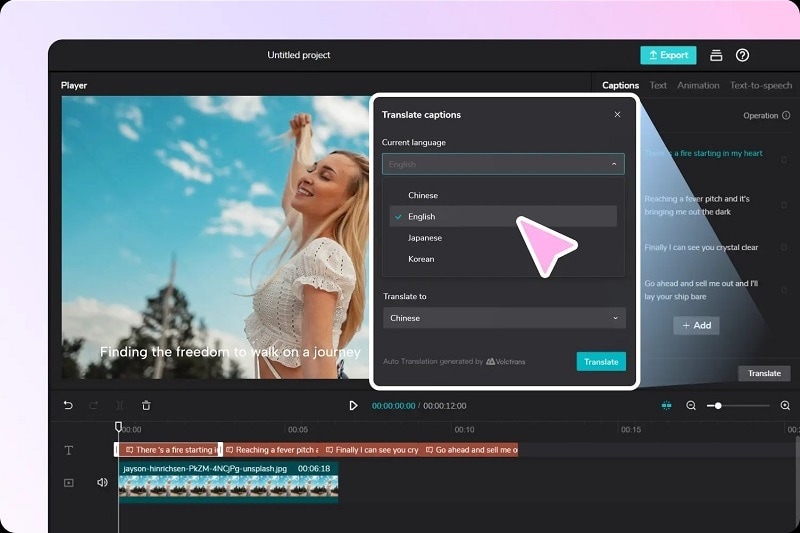
- Step 3: After translating the video content, preview the subtitles to ensure accuracy and formatting. Once satisfied, export the translated video with subtitles embedded. Share it across various platforms or channels to reach your intended audience.

If the auto translation of CapCut isn’t accessible to you, Wondershare Virbo is an excellent alternative. It offers efficient AI-powered translation features with an intuitive interface and robust capabilities.
Part 2. Wondershare Virbo: The Perfect CapCut Alternative Assisted by AI
Wondershare Virbo is an exceptional alternative tool for video translations. Virbo empowers you to translate and enhance your video content for global audiences. Let’s delve into the platform’s key features:

Get Started Online Free Download
- Versatile compatibility. Virbo has an offline and online version. The app ensures seamless integration into your workflow.
- AI cloning voices. Virbo enables you to replicate voices with remarkable accuracy. It’s useful for dubbing or voice-over projects.
- Auto-generate scripts. The app generates scripts based on the audio content of videos. The feature saves time and effort. It allows you to focus on refining and enhancing your content rather than transcribing it.
- Soundtrack reversed. Virbo offers a unique feature that allows you to reverse the soundtrack of videos. It adds a creative dimension to your content.
- Multilingual support. Virbo supports up to 20+ languages to optimize your content.
- Subtitle translation. Virbo can automatically translate the uploaded video’s subtitles. It supports the translation tasks of 28 languages, including English, French, Spanish, German, etc.
Different Use Cases of Wondershare Virbo
With its intuitive interface and robust capabilities, Virbo streamlines the localization process. It saves you time and effort for your video content. Here are use cases where you can take advantage of Virbo:
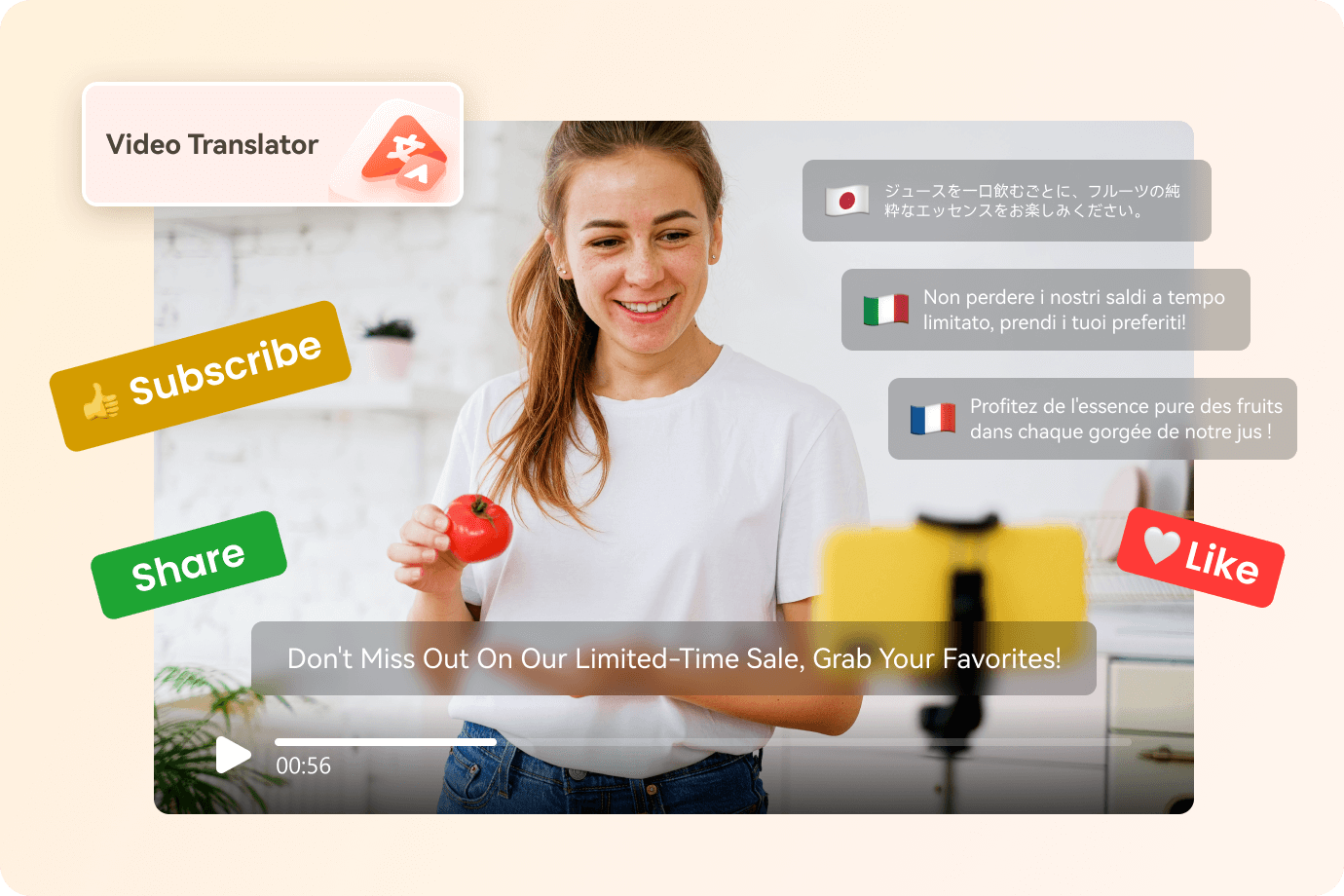
- Video advertising for global impact. Virbo’s AI translation and voice cloning allow companies to localize content for various markets. It maximizes engagement and conversion rates.
- Streamlined media production. Virbo offers automated script generation and voice cloning features. It provides content creators with efficient workflow management.
- Optimized corporate interactions. The app helps in real-time translation and voice cloning for presentations, training videos, and more. It ensures that companies can engage with employees and stakeholders across language barriers.
How To Translate Subtitles With Virbo
Follow these steps to enhance your video content and reach global audiences with Virbo:
- Step 1: Download and install Wondershare Virbo on your computer. You can also use the Virbo online tool . Once installed, launch the app. Log in with your Email, Wondershare, Google, Facebook, or Twitter account. Click the Video Translator button to start the process.
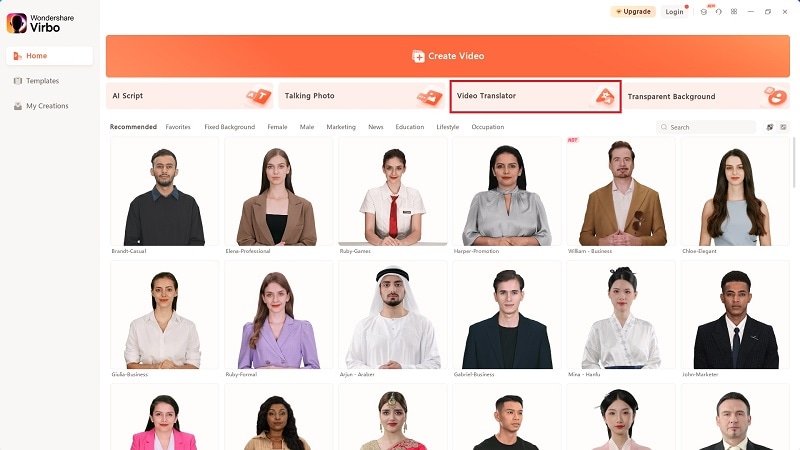
Get Started Online Free Download
- Step 2: Choose the video for translation saved on your computer. Choose the original and translated languages on the right side of the interface. In the advanced settings, decide if you like to add subtitles or lip-sync. Next, click on Translate Video.
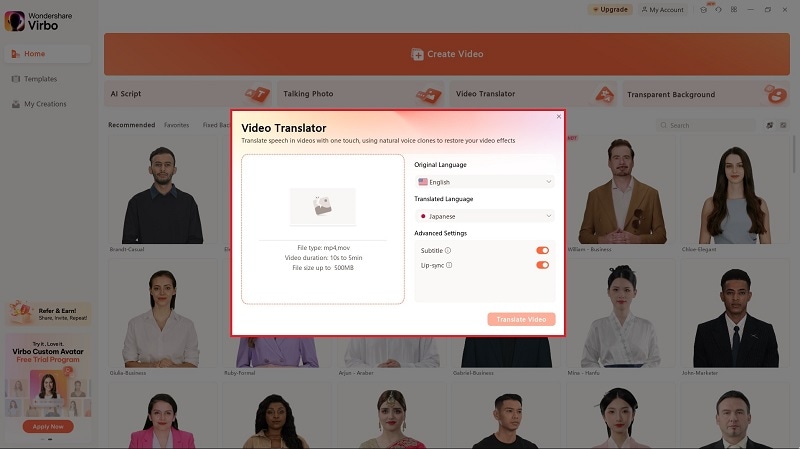
- Step 3: Wait for the translation process to complete. Once done, preview the AI-translated video to ensure accuracy and quality. If satisfied, download or export the translated video in your preferred format. Share your content afterward.

Part 3. Comparative Analysis: CapCut Translate vs. Wondershare Virbo
When considering video translation needs, several factors come into play. Here are the pros and cons of CapCut and Virbo.

CapCut Translate
CapCut Translate excels in its simplicity and affordability. Here are its pros and cons:
Pros
- · CapCut offers an easy-to-use interface.
- · You can customize subtitles from font styles, sizes, and colors.
- · CapCut auto-detects any language for easy translation.
Cons
- · CapCut doesn’t support frame rates higher than 60 fps.
- · The mobile app doesn’t support landscape mode.
Wondershare Virbo
Wondershare Virbo stands out with its advanced AI features and comprehensive language support. Here are its pros and cons:
Pros
- · Wondershare Virbo includes voice cloning and auto-script generation. It enhances translation accuracy and efficiency.
- · Virbo offers support for a wide range of languages. It ensures comprehensive coverage for diverse global audiences.
- · Virbo’s online and offline versions provide you flexibility in accessing its translation services.
Cons
- · Script generation is limited for free users.
- · Free users can only export 1 video at a time.
Pricing
Both CapCut and Virbo offer free versions. However, Virbo offers a comprehensive suite of features available on its paid plans (as of March 5, 2024):
- Monthly Plan: $9.9/month
- Yearly Plan - Essential: $19.9/year
- Yearly Plan - Pro: $199/year
The monthly plan includes 10 minutes of video credits per month. Meanwhile, the yearly essential plan provides 22 minutes per year. The annual pro plan offers 300 minutes per year. The monthly plan supports videos that are up to 2 minutes in duration. Both the annual plans allow up to 5 minutes. All plans offer a maximum resolution of 1080p and unlimited time for AI scripts.
Conclusion
CapCut Translate and Virbo offer creators valuable translation solutions. However, Virbo’s advanced AI features and language support make it a compelling choice. It’s an ideal app for users seeking top-tier translation capabilities.
The importance of selecting the right tool based on your needs cannot be overstated. It’s recommended that you test the auto-translation of CapCut and Virbo to determine the right tool for you. However, for those seeking powerful features and efficient translation, Virbo is the preferred option. Choose wisely to ensure your content reaches its full global potential**.**
Wondershare Virbo
Wondershare Virbo stands out with its advanced AI features and comprehensive language support. Here are its pros and cons:
Pros
- · Wondershare Virbo includes voice cloning and auto-script generation. It enhances translation accuracy and efficiency.
- · Virbo offers support for a wide range of languages. It ensures comprehensive coverage for diverse global audiences.
- · Virbo’s online and offline versions provide you flexibility in accessing its translation services.
Cons
- · Script generation is limited for free users.
- · Free users can only export 1 video at a time.
Pricing
Both CapCut and Virbo offer free versions. However, Virbo offers a comprehensive suite of features available on its paid plans (as of March 5, 2024):
- Monthly Plan: $9.9/month
- Yearly Plan - Essential: $19.9/year
- Yearly Plan - Pro: $199/year
The monthly plan includes 10 minutes of video credits per month. Meanwhile, the yearly essential plan provides 22 minutes per year. The annual pro plan offers 300 minutes per year. The monthly plan supports videos that are up to 2 minutes in duration. Both the annual plans allow up to 5 minutes. All plans offer a maximum resolution of 1080p and unlimited time for AI scripts.
Conclusion
CapCut Translate and Virbo offer creators valuable translation solutions. However, Virbo’s advanced AI features and language support make it a compelling choice. It’s an ideal app for users seeking top-tier translation capabilities.
The importance of selecting the right tool based on your needs cannot be overstated. It’s recommended that you test the auto-translation of CapCut and Virbo to determine the right tool for you. However, for those seeking powerful features and efficient translation, Virbo is the preferred option. Choose wisely to ensure your content reaches its full global potential**.**
A Complete Guide To Translate Video With Google
We live in an age when technology is ever-evolving. Google, being a leader in technological innovation, has introduced several tools that make communication more seamless. Most of us are already familiar with one such tool, Google Translate. After all, it’s the go-to text translation option for many people. But can it be used for translating a video? We will answer this question in detail below. So, let’s dive into the world of Google Translate Video.
Part 1: Benefits of Using Google Translate for Video Translation
Below are some of the biggest benefits of using Google Translate for translating videos:
1. Google Translate Saves Money
Most tools need money to access premium features, but not Google. Google Translate is absolutely free of cost. You can use it for hour-long videos and this service won’t charge you a dime. This can help you save some bucks on hiring professional translation services.
2. Google Translate Supports Almost All Languages
That’s correct. Google Translate currently supports 133 languages of the world. That means with the help of Google Translate you can reach a much wider global language than any other service. You can easily translate your tutorials, how-to guides, podcasts, social media posts, scripts etc to reach as many people as possible.
3. Google Translate Works In Real Time
Google Translate provides instant translations. You don’t have to wait for the AI to understand the language first and then provide accurate translations. So, Google Translate video can be a lifesaver for content creators who are always on the go and need instant access to translations for their content.
4. Google Translate Needs No Installation or Sign Up
Most translation tools require either a sign up or software installation, Google Translation is straightforward to use. Simply copy your content and paste it into the translation window. Google Translate will instantly pick up the language to give you the translation. It’s that simple.
5. Google Translate Also Works Offline
The biggest benefit of Google Translate is uninterrupted service. You can download Google Translate app on your mobile phones and translate content offline. It can be particularly beneficial for content creators who don’t always have an internet connection.
Part 2: Step Guidance: How To Get Google Translate to Translate A Video
If you are a beginner the following steps may seem a bit of work, but let me assure you, they are very straightforward. Follow along to Google translate videos:
Translate Video Online Download APP Now Free Download
Step1Upload Your Video To Virbo
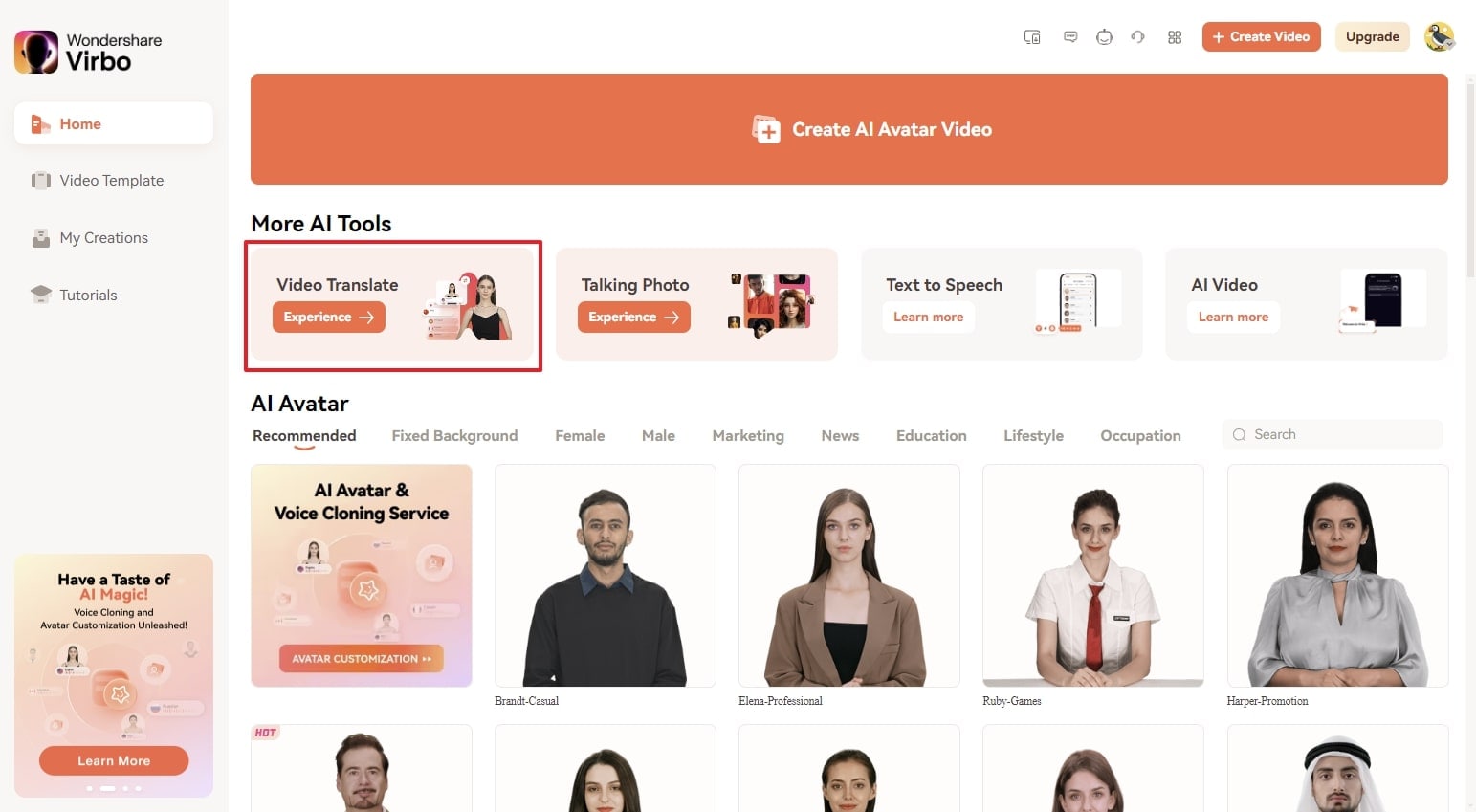
Virbo is an AI Video Editor. Among other features, it has a fantastic online video translator that you can use to translate videos into 20+ languages.
So, go to Virbo, and then click on Video Translator Tool in the top right corner. Upload your video.
Step2Select Source & Target Language To Translate Your Video
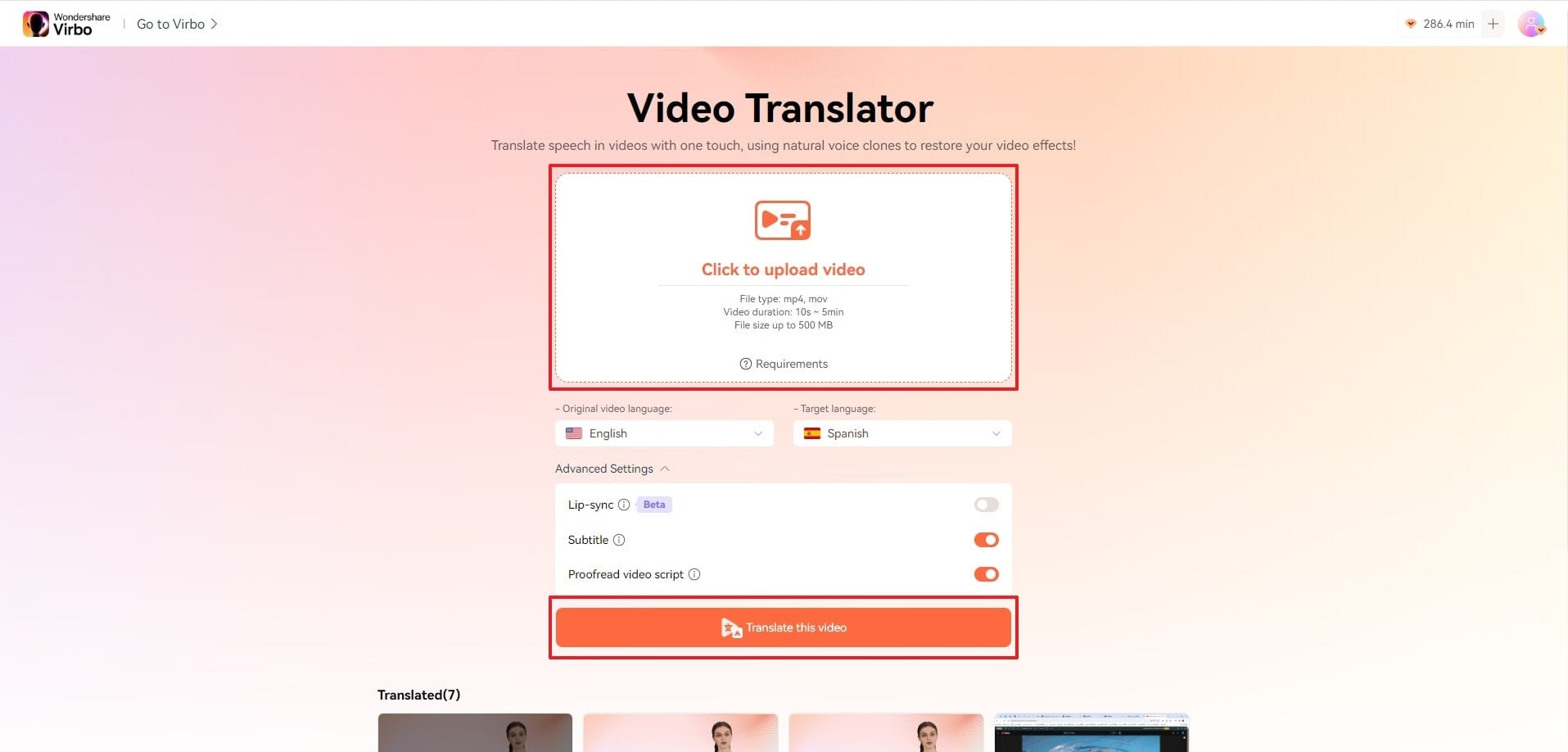
When video is done uploading, you will see the option to select Source and Target languages. Select your video language as the Source, and the language you want it translated into as the Target.
You can download subtitles as SRT or TXT files.
Step3 Use Google Translate to Further Improve Translation

Finally, copy and paste the subtitles on Google Translate and get your desired translation.
That’s all. That’s how you successfully Googel Transalte a video
Part 3: Best Alternatives To Google Translate
Below are some alternatives you can use if Google Translate is unavailable. These options are just as good, if not better.
1. Virbo
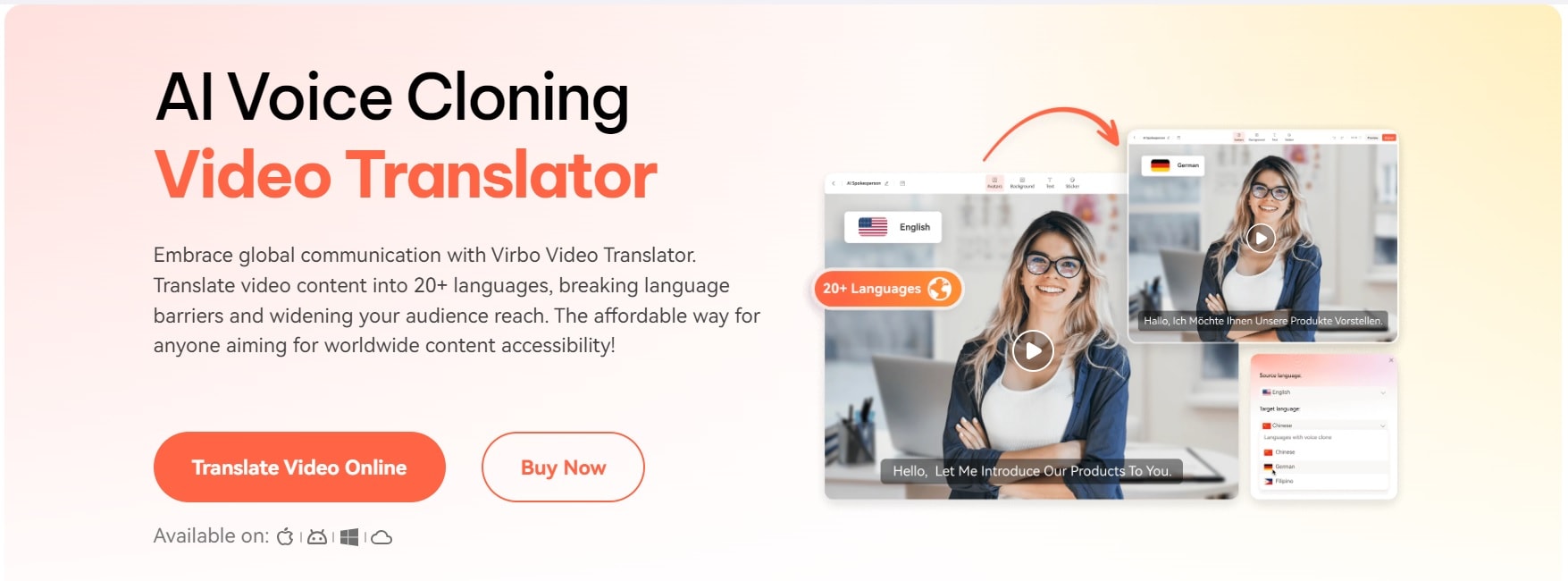
Translate Video Online Download APP Now Free Download
We previously mentioned Virbo for burning subtitles on your Video. But you can also use it to translate a video, edit subtitles, create instant dubs/voiceovers, make AI avatar videos and do so much more. It is a great option if you want a host of features to streamline your content creation process besides mere subtitle translation. Virbo is available on all major platforms, such as Online Browsers, PC/Laptop, Android, and iOS devices.
2. Microsoft Translator

Microsoft Translator is another great option for video translation. It allows real time translated conversations across multiple devices and platforms. Another difference between Google and Microsoft Translator is that Microsoft’s Translator supports fewer languages. It’s only available for 103 languages, which is still more than big name translation services. A unique feature of Microsoft Translator is that it is also compatible with the MS Office suite. So you can use it with MS Excel, One Note, PowerPoint and Outlook. Lastly, this tool is particularly helpful with contextual understanding of a sentence.
3. SubtitleBee

SubtitleBee is also a great service to quickly translate and add subtitles to online videos. With a reported accuracy rate of 95%, this service is among some of the most accurate in the market. Moreover, it allows you to customize subtitles, edit and add cool font styles, colors, background details and orientation to create your unique projects. Another great feature is that with SubtitleBee you can add subtitles anywhere on screen. Even on top, if you so want. It also has a supertitles feature as a bonus, which enables you to add head titles on videos.
Part 4: FAQs about Google Translate Video Audio
1. Can I translate a full video with Google Translate?
Of course, you can use Google Translate to get the translation of any length video. You will first have to transcribe the entire audio and then translate that transcript with the help of Google Video. You can use services like Virbo to add these translated subtitles to the original video.
2. Does Google Translate really work for video translation?
Well, Google Translate does not directly translate a video. You have to integrate it with other services like YouTube to get translation and then use Google Translate as a secondary tool to translate a video.
3. Can I get a translated video in my native language?
Yes, Google Translate supports almost 133 languages of the world. If your native language is spoken by a large population, chances are Google supports its translation to and from other languages. So, you can get a translated video in your native language.
4. What languages does Google Translate support?
Google Translate supports approximately 133 languages of the world at the moment. But it keeps on adding new language support every once in a while. You can get translations in all popular languages like English, Chinese, Spanish, French, Japanese, Hindi, Italian, Russian, Korean, etc.
Conclusion
That’s pretty much all about translating a video using Google Translate. Tools like Google Translate and Wondershare Virbo make our world more connected than ever. They bridge boundaries and bring people together. But, don’t forget, if you are translating any copyrighted content with Google Translate, you may need permission. Translating copyrighted content without permission is still copyright infringement. Use these tools with responsibility. Now, go on, Google Translate video online. Good luck 
Step1Upload Your Video To Virbo

Virbo is an AI Video Editor. Among other features, it has a fantastic online video translator that you can use to translate videos into 20+ languages.
So, go to Virbo, and then click on Video Translator Tool in the top right corner. Upload your video.
Step2Select Source & Target Language To Translate Your Video

When video is done uploading, you will see the option to select Source and Target languages. Select your video language as the Source, and the language you want it translated into as the Target.
You can download subtitles as SRT or TXT files.
Step3 Use Google Translate to Further Improve Translation

Finally, copy and paste the subtitles on Google Translate and get your desired translation.
That’s all. That’s how you successfully Googel Transalte a video
Part 3: Best Alternatives To Google Translate
Below are some alternatives you can use if Google Translate is unavailable. These options are just as good, if not better.
1. Virbo

Translate Video Online Download APP Now Free Download
We previously mentioned Virbo for burning subtitles on your Video. But you can also use it to translate a video, edit subtitles, create instant dubs/voiceovers, make AI avatar videos and do so much more. It is a great option if you want a host of features to streamline your content creation process besides mere subtitle translation. Virbo is available on all major platforms, such as Online Browsers, PC/Laptop, Android, and iOS devices.
2. Microsoft Translator

Microsoft Translator is another great option for video translation. It allows real time translated conversations across multiple devices and platforms. Another difference between Google and Microsoft Translator is that Microsoft’s Translator supports fewer languages. It’s only available for 103 languages, which is still more than big name translation services. A unique feature of Microsoft Translator is that it is also compatible with the MS Office suite. So you can use it with MS Excel, One Note, PowerPoint and Outlook. Lastly, this tool is particularly helpful with contextual understanding of a sentence.
3. SubtitleBee

SubtitleBee is also a great service to quickly translate and add subtitles to online videos. With a reported accuracy rate of 95%, this service is among some of the most accurate in the market. Moreover, it allows you to customize subtitles, edit and add cool font styles, colors, background details and orientation to create your unique projects. Another great feature is that with SubtitleBee you can add subtitles anywhere on screen. Even on top, if you so want. It also has a supertitles feature as a bonus, which enables you to add head titles on videos.
Part 4: FAQs about Google Translate Video Audio
1. Can I translate a full video with Google Translate?
Of course, you can use Google Translate to get the translation of any length video. You will first have to transcribe the entire audio and then translate that transcript with the help of Google Video. You can use services like Virbo to add these translated subtitles to the original video.
2. Does Google Translate really work for video translation?
Well, Google Translate does not directly translate a video. You have to integrate it with other services like YouTube to get translation and then use Google Translate as a secondary tool to translate a video.
3. Can I get a translated video in my native language?
Yes, Google Translate supports almost 133 languages of the world. If your native language is spoken by a large population, chances are Google supports its translation to and from other languages. So, you can get a translated video in your native language.
4. What languages does Google Translate support?
Google Translate supports approximately 133 languages of the world at the moment. But it keeps on adding new language support every once in a while. You can get translations in all popular languages like English, Chinese, Spanish, French, Japanese, Hindi, Italian, Russian, Korean, etc.
Conclusion
That’s pretty much all about translating a video using Google Translate. Tools like Google Translate and Wondershare Virbo make our world more connected than ever. They bridge boundaries and bring people together. But, don’t forget, if you are translating any copyrighted content with Google Translate, you may need permission. Translating copyrighted content without permission is still copyright infringement. Use these tools with responsibility. Now, go on, Google Translate video online. Good luck 
How To Translate Video From Japanese to English Online?
Let’s say you’re a business owner or a content creator in Japan. If you want to broaden your horizons, you may need to translate videos from Japanese to English. This is because English is spoken globally. You can sell more, share knowledge, and connect with English speakers worldwide.
For streaming platforms, turning Japanese content into English is a ticket to reaching audiences all over the globe. And businesses using Japanese tech might need translated training videos for their remote workers.
Seeing this growing need, it’s clear you need effective video translation solutions. So, we’ve created a guide to help you choose the best method for each step, including using AI. Finding the right way to translate videos is important, so keep reading!

Part I. Completed Process To Translate Videos From Japanese to English
When you want to translate a video from Japanese to English, you can follow some general steps, no matter how you decide to do it. Let’s break down each step for you:
- Step 1: Video Transcription
Before you can translate, you need to understand what’s being said. So, the initial step is to do a video transcription. You can either hire professionals or use a Japanese-to-English video translator app to convert the spoken language to text.
Transcription captures all the Japanese dialogue, ensuring the English translation is spot-on. Having the text file lets you edit it, like shortening sentences or adjusting cultural references. This results in a smoother and more natural English video for you.
- Step 2: Translation
Once you have the transcript, you can translate the Japanese text into English. A good translation ensures the original message is accurately conveyed in the new language. It avoids any misunderstandings or misinterpretations for your English viewers. You have two options to do it. Both have strengths and weaknesses, so let’s see which suits your needs best.
- Professional Human Translation Services
When you want to translate a video from Japanese to English, a pro can make the sentences sound right for your audience. These professionals tweak the tone to be natural and engaging. If you go to translation agencies, they make sure the work is top-notch by going through strict editing and reviewing. However, human translation services cost more and take a bit more time than machine translation tools.
- Machine Translation Tools
Machine translation tools are fast and affordable. They can be a good option for short, simple videos where perfect accuracy isn’t critical. But it often struggles with complex language, cultural references, and humor.
- Step 3: Timing and Implementation
Let’s talk about making the Japanese to English video translation seamless. After translating, you want the words to match the original rhythm and pace of the speaker in the video. It keeps things feeling natural and engaging for you, the viewer. Plus, speakers use non-verbal cues like jokes, emotions, and pauses. Matching the translated text with these visual cues keeps the video’s meaning and impact intact.
How to do it? Professional workflows often use timecode, which gives each video frame a unique timestamp. It ensures super precise subtitle placement for that perfect synchronization. Some video editing tools even have “waveforms” to help visually line up subtitles with the spoken parts.

Here are several ways to add the translated Japanese text to your video:
- Subtitles
Subtitles are like on-screen translators for you. They show the English dialogue while the original Japanese audio goes on. It helps you understand if you get the visuals but not the language. The focus is on getting the main point across and sometimes making the sentences shorter for easier reading.
- Closed Captions
Like subtitles, closed captions (CC) are words shown on the screen. They go beyond spoken words, covering all the sounds you hear, like dialogue, music, and even background noises. The main goal is to help you, especially if you’re deaf or struggle with hearing. So, if you’re aiming for videos everyone can enjoy, try a video translator from Japanese to English with CC capabilities.
- Dubbing
Dubbing is a more intricate process where the original Japanese audio track is completely replaced. Voice actors step in to record the translated script in English. They try to sync up their words with the lip movements of the characters on screen. It makes it seem like the characters speak English right from the start, giving you a more immersive viewing experience.
- Voiceover
In this method, a narrator reads the translated script in English over the original Japanese audio. It’s often used in documentaries or educational videos when you need more info beyond just the dialogue.
- Step 4: Final Review and Approval
Alright, so you’re at the last step now. You’re giving the translated video a good check to ensure everything’s spot-on – accurate, consistent, and top-notch quality. It means looking out for any problems in the translation, timing, or how you choose to do it. Once you give the thumbs up to the final version, you’ve got a smooth and effective English video ready for your audience.
You might find the previous steps tedious and time-consuming. But what if you could translate your video from Japanese to English in minutes? That way, you could reach new markets and expand your influence faster. AI video translators like Wondershare Virbo can help you spread your work, passions, and stories to a global audience. Read on to learn more.
Part II. Virbo: Realistic AI Japanese to English Video Translator
You’re excited about your new product, but your explainer video feels like it’s only speaking to half the world. You know the potential exists, but the language barrier holds you back. Or perhaps you’ve captured stunning footage from your recent trip to Kyoto, but sharing it with your followers feels like a lost cause.
Here’s the deal: you don’t have to stick to a small crowd.

Get Started Online Free Download
Virbo uses the latest AI tech to automatically translate, dub voice, and add synced subtitles to your Japanese video. This app is simple to use and can translate video content into over 20 languages. Virbo translates Japanese to English videos in a few minutes – all free for videos under 2 minutes!
Here’s what makes Virbo stand out:
- Precise Lip-sync: Say goodbye to awkward, out-of-sync translations. Virbo AI video translator ensures the translated dialogue seamlessly matches the speaker’s lip movements and facial expressions, creating a natural and engaging experience (still in beta, but getting better every day!).
- AI Cloning Voices: Add engagement with Virbo’s AI-cloned voices that capture the essence of human speech. Choose from a range of natural-sounding voices that express the right emotions and add personality to your content.
- Soundtrack Reserved: Don’t lose the original soundtrack that sets the mood. Virbo allows you to keep it intact, enhancing its impact even in different languages.
- Versatile Compatibility: Virbo works across various platforms, including Windows, iOS, and Android. You can even use it online for ultimate flexibility.
- Affordable Excellence: Experience the power of AI video translation without breaking the bank. Virbo offers high-quality solutions at affordable prices, making them accessible to everyone.
Part III. How To Translate Japanese to English Video Using Virbo Automatically
Using Virbo AI video translator can help you be more productive. Here’s how to translate a video in Japanese to English online for free:
- Step 1: Go to Virbo AI video translator online from your browser for quick access. You can also download the app for your desktop. Once you’ve chosen your access point, sign in using your existing Google, Facebook, email, Apple, or Twitter account.
Get Started Online Free Download
- Step 2: Choose and upload your Japanese video file from your local storage. Ensure the video is between 10 seconds to 5 minutes long and in MP4 or MOV format, up to 500 MB for optimal processing.
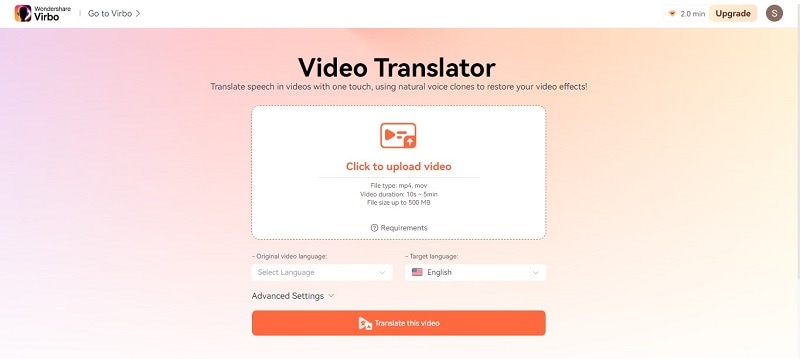
- Step 3: Specify Japanese as the Original video language and English as the desired Target language.
- Step 4: Virbo offers Advanced Settings to customize the translated view result. Toggle on the Lip-sync, Subtitle, and Proofread video script switches to enable them when needed.
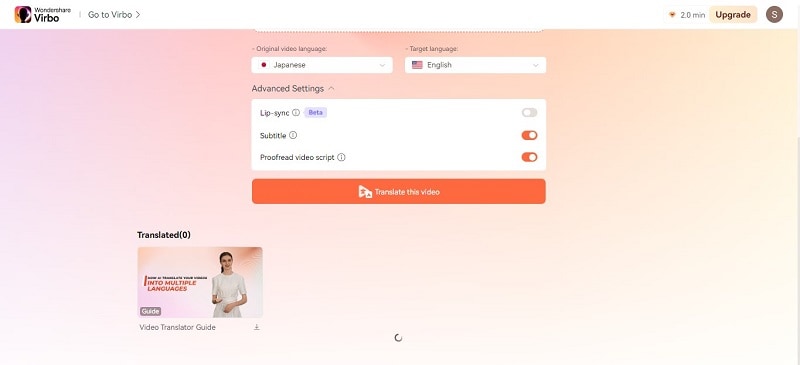
- Step 5: Click Translate this video to start the translation process once everything is set.
- Step 6: Wait a few moments while Virbo performs video transcription. Review the text and edit if needed.
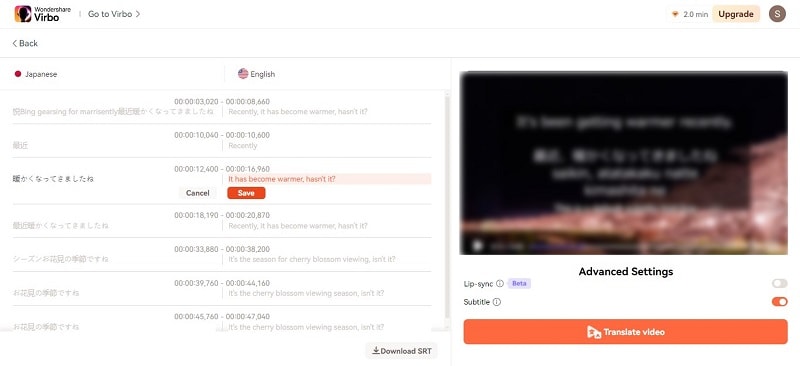
- Step 7: Click Translate video to proceed, then the video will go to the queue.
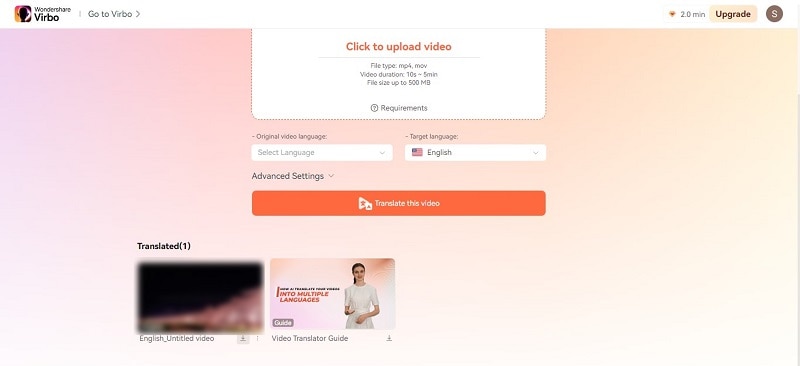
- Step 8: After completion, you can preview the translated video before downloading the final English version.
Part IV. How To Achieve the Best Video Translation Results?
You can’t always translate a video from Japanese to English without a few difficulties. Here are some ways to make the process easier for you:
Divide the Script Into Manageable Chunks
Break down the script into smaller sections like sentences, phrases, or even shorter segments depending on the video’s pace and complexity. It allows for more precise timing adjustments later.
Use a “Shadowing” Technique
As you watch the video, read the translated text out loud. Adjust the subtitle timing to match how you naturally speak. Doing this makes the flow feel more natural for you and the viewers.
Test and Refine
Now that you’ve set the timing for the subtitles, it’s time to put them to the test with your target audience. This step is important because it helps you catch any timing problems, awkward phrasing, or cultural differences that might have slipped through during editing.
Listen to what your audience says, and then use that feedback to tweak the subtitles. Your goal is to make sure they’re clear, short, and match the audience’s culture.
AI for Pre-Translation Tasks
Take advantage of AI tools for speech-to-text conversion and automatic subtitle generation. It can save time, but always proofread for accuracy and natural flow.
File Compatibility
Ensure your chosen translation service or tool supports the format of your video file. The common formats include MP4, MOV, and AVI.
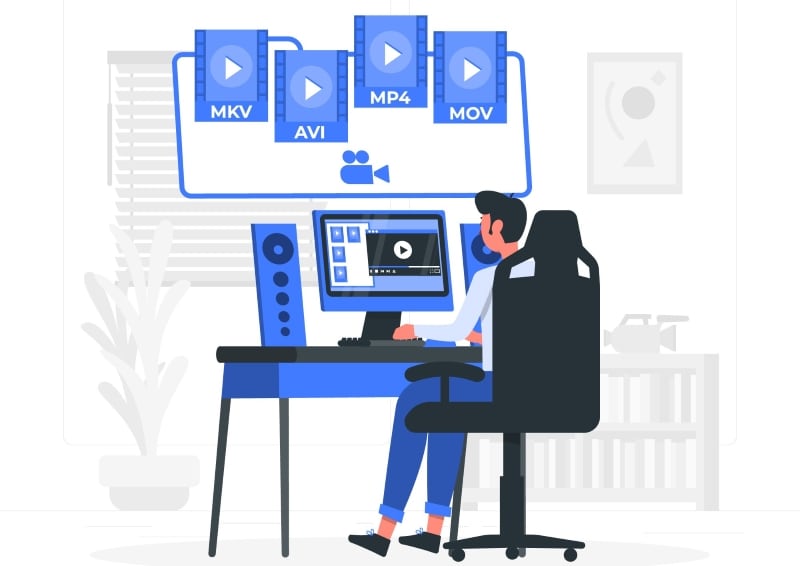
Conclusion
So you’ve seen how easy it can be to translate a video from Japanese to English. It’s up to you whether you will ask for the help of human translators, video editors, or AI video translators.
As you know, Virbo goes beyond being a basic Japanese to English video translator and converter. It takes the complexity out of translation, offering seamless and accurate results.
But remember, even the best AI translation can benefit from a human touch. Don’t be afraid to experiment and refine your translated video for the best outcome. With a little effort, you can bridge the language barrier and share your Japanese video content with the world.
Let’s say you’re a business owner or a content creator in Japan. If you want to broaden your horizons, you may need to translate videos from Japanese to English. This is because English is spoken globally. You can sell more, share knowledge, and connect with English speakers worldwide.
For streaming platforms, turning Japanese content into English is a ticket to reaching audiences all over the globe. And businesses using Japanese tech might need translated training videos for their remote workers.
Seeing this growing need, it’s clear you need effective video translation solutions. So, we’ve created a guide to help you choose the best method for each step, including using AI. Finding the right way to translate videos is important, so keep reading!

Part I. Completed Process To Translate Videos From Japanese to English
When you want to translate a video from Japanese to English, you can follow some general steps, no matter how you decide to do it. Let’s break down each step for you:
- Step 1: Video Transcription
Before you can translate, you need to understand what’s being said. So, the initial step is to do a video transcription. You can either hire professionals or use a Japanese-to-English video translator app to convert the spoken language to text.
Transcription captures all the Japanese dialogue, ensuring the English translation is spot-on. Having the text file lets you edit it, like shortening sentences or adjusting cultural references. This results in a smoother and more natural English video for you.
- Step 2: Translation
Once you have the transcript, you can translate the Japanese text into English. A good translation ensures the original message is accurately conveyed in the new language. It avoids any misunderstandings or misinterpretations for your English viewers. You have two options to do it. Both have strengths and weaknesses, so let’s see which suits your needs best.
- Professional Human Translation Services
When you want to translate a video from Japanese to English, a pro can make the sentences sound right for your audience. These professionals tweak the tone to be natural and engaging. If you go to translation agencies, they make sure the work is top-notch by going through strict editing and reviewing. However, human translation services cost more and take a bit more time than machine translation tools.
- Machine Translation Tools
Machine translation tools are fast and affordable. They can be a good option for short, simple videos where perfect accuracy isn’t critical. But it often struggles with complex language, cultural references, and humor.
- Step 3: Timing and Implementation
Let’s talk about making the Japanese to English video translation seamless. After translating, you want the words to match the original rhythm and pace of the speaker in the video. It keeps things feeling natural and engaging for you, the viewer. Plus, speakers use non-verbal cues like jokes, emotions, and pauses. Matching the translated text with these visual cues keeps the video’s meaning and impact intact.
How to do it? Professional workflows often use timecode, which gives each video frame a unique timestamp. It ensures super precise subtitle placement for that perfect synchronization. Some video editing tools even have “waveforms” to help visually line up subtitles with the spoken parts.

Here are several ways to add the translated Japanese text to your video:
- Subtitles
Subtitles are like on-screen translators for you. They show the English dialogue while the original Japanese audio goes on. It helps you understand if you get the visuals but not the language. The focus is on getting the main point across and sometimes making the sentences shorter for easier reading.
- Closed Captions
Like subtitles, closed captions (CC) are words shown on the screen. They go beyond spoken words, covering all the sounds you hear, like dialogue, music, and even background noises. The main goal is to help you, especially if you’re deaf or struggle with hearing. So, if you’re aiming for videos everyone can enjoy, try a video translator from Japanese to English with CC capabilities.
- Dubbing
Dubbing is a more intricate process where the original Japanese audio track is completely replaced. Voice actors step in to record the translated script in English. They try to sync up their words with the lip movements of the characters on screen. It makes it seem like the characters speak English right from the start, giving you a more immersive viewing experience.
- Voiceover
In this method, a narrator reads the translated script in English over the original Japanese audio. It’s often used in documentaries or educational videos when you need more info beyond just the dialogue.
- Step 4: Final Review and Approval
Alright, so you’re at the last step now. You’re giving the translated video a good check to ensure everything’s spot-on – accurate, consistent, and top-notch quality. It means looking out for any problems in the translation, timing, or how you choose to do it. Once you give the thumbs up to the final version, you’ve got a smooth and effective English video ready for your audience.
You might find the previous steps tedious and time-consuming. But what if you could translate your video from Japanese to English in minutes? That way, you could reach new markets and expand your influence faster. AI video translators like Wondershare Virbo can help you spread your work, passions, and stories to a global audience. Read on to learn more.
Part II. Virbo: Realistic AI Japanese to English Video Translator
You’re excited about your new product, but your explainer video feels like it’s only speaking to half the world. You know the potential exists, but the language barrier holds you back. Or perhaps you’ve captured stunning footage from your recent trip to Kyoto, but sharing it with your followers feels like a lost cause.
Here’s the deal: you don’t have to stick to a small crowd.

Get Started Online Free Download
Virbo uses the latest AI tech to automatically translate, dub voice, and add synced subtitles to your Japanese video. This app is simple to use and can translate video content into over 20 languages. Virbo translates Japanese to English videos in a few minutes – all free for videos under 2 minutes!
Here’s what makes Virbo stand out:
- Precise Lip-sync: Say goodbye to awkward, out-of-sync translations. Virbo AI video translator ensures the translated dialogue seamlessly matches the speaker’s lip movements and facial expressions, creating a natural and engaging experience (still in beta, but getting better every day!).
- AI Cloning Voices: Add engagement with Virbo’s AI-cloned voices that capture the essence of human speech. Choose from a range of natural-sounding voices that express the right emotions and add personality to your content.
- Soundtrack Reserved: Don’t lose the original soundtrack that sets the mood. Virbo allows you to keep it intact, enhancing its impact even in different languages.
- Versatile Compatibility: Virbo works across various platforms, including Windows, iOS, and Android. You can even use it online for ultimate flexibility.
- Affordable Excellence: Experience the power of AI video translation without breaking the bank. Virbo offers high-quality solutions at affordable prices, making them accessible to everyone.
Part III. How To Translate Japanese to English Video Using Virbo Automatically
Using Virbo AI video translator can help you be more productive. Here’s how to translate a video in Japanese to English online for free:
- Step 1: Go to Virbo AI video translator online from your browser for quick access. You can also download the app for your desktop. Once you’ve chosen your access point, sign in using your existing Google, Facebook, email, Apple, or Twitter account.
Get Started Online Free Download
- Step 2: Choose and upload your Japanese video file from your local storage. Ensure the video is between 10 seconds to 5 minutes long and in MP4 or MOV format, up to 500 MB for optimal processing.

- Step 3: Specify Japanese as the Original video language and English as the desired Target language.
- Step 4: Virbo offers Advanced Settings to customize the translated view result. Toggle on the Lip-sync, Subtitle, and Proofread video script switches to enable them when needed.

- Step 5: Click Translate this video to start the translation process once everything is set.
- Step 6: Wait a few moments while Virbo performs video transcription. Review the text and edit if needed.

- Step 7: Click Translate video to proceed, then the video will go to the queue.

- Step 8: After completion, you can preview the translated video before downloading the final English version.
Part IV. How To Achieve the Best Video Translation Results?
You can’t always translate a video from Japanese to English without a few difficulties. Here are some ways to make the process easier for you:
Divide the Script Into Manageable Chunks
Break down the script into smaller sections like sentences, phrases, or even shorter segments depending on the video’s pace and complexity. It allows for more precise timing adjustments later.
Use a “Shadowing” Technique
As you watch the video, read the translated text out loud. Adjust the subtitle timing to match how you naturally speak. Doing this makes the flow feel more natural for you and the viewers.
Test and Refine
Now that you’ve set the timing for the subtitles, it’s time to put them to the test with your target audience. This step is important because it helps you catch any timing problems, awkward phrasing, or cultural differences that might have slipped through during editing.
Listen to what your audience says, and then use that feedback to tweak the subtitles. Your goal is to make sure they’re clear, short, and match the audience’s culture.
AI for Pre-Translation Tasks
Take advantage of AI tools for speech-to-text conversion and automatic subtitle generation. It can save time, but always proofread for accuracy and natural flow.
File Compatibility
Ensure your chosen translation service or tool supports the format of your video file. The common formats include MP4, MOV, and AVI.

Conclusion
So you’ve seen how easy it can be to translate a video from Japanese to English. It’s up to you whether you will ask for the help of human translators, video editors, or AI video translators.
As you know, Virbo goes beyond being a basic Japanese to English video translator and converter. It takes the complexity out of translation, offering seamless and accurate results.
But remember, even the best AI translation can benefit from a human touch. Don’t be afraid to experiment and refine your translated video for the best outcome. With a little effort, you can bridge the language barrier and share your Japanese video content with the world.
Also read:
- [New] In 2024, Top 30 Camcorders Recommended for Snow Activities
- [Updated] 2024 Approved This Year’s Offbeat Movie Masterpieces
- [Updated] In 2024, Transform Your FB Advertising Simplify with a Free Toolkit
- [Updated] Mellow Your Playlist Device-Specific Techniques for 2024
- 9 Best French Video Translators Online and Download Options
- Anticipating the Next Apple Event? Dates, News Scoops, and Hot Gossip Await
- Comprehensive Evaluation Gecata Pro Monitoring for 2024
- HandsOnGuide to YourWebcamRecord for 2024
- How to Use ChatGPT to Improve Your Entire Lifestyle
- In 2024, Convert Video Voice to Text Online for Free Fast and Easy Ways
- New 2024 Approved Best Video Translator App for PC You Cannot Miss
- New Maximizing Yandex Translate in Video Translation and Beyond for 2024
- Top 10 AI Subtitle Translators for Content Creators That Anyone Can Use
- Updated Translate Video From Japanese to English Online for Free
- Title: In 2024, Revealing Translation Methods Netflix Subtitle Software Comprehensive Guide
- Author: Susan
- Created at : 2024-09-27 16:11:49
- Updated at : 2024-09-30 17:48:30
- Link: https://ai-video-translation.techidaily.com/in-2024-revealing-translation-methods-netflix-subtitle-software-comprehensive-guide/
- License: This work is licensed under CC BY-NC-SA 4.0.